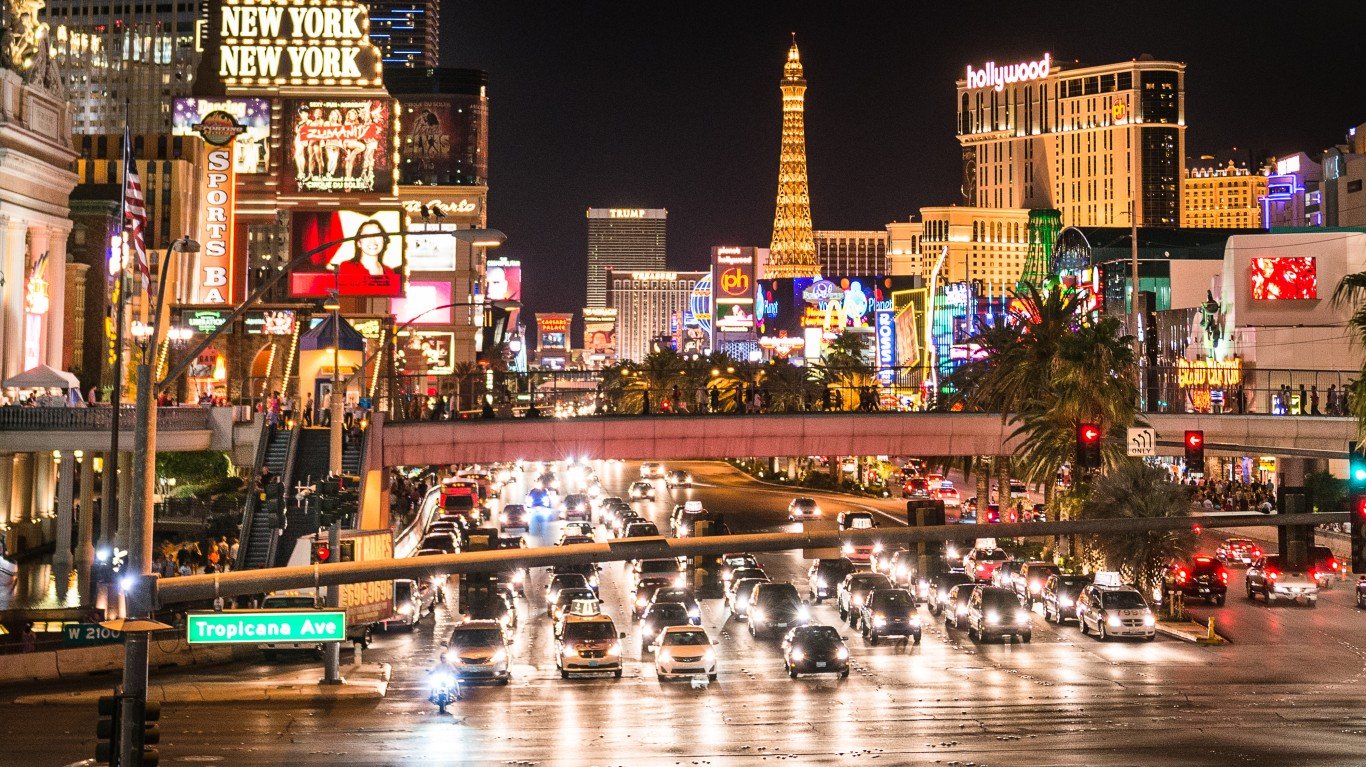

Since the height of the COVID-19 pandemic, the number of Americans working from home has fallen sharply. Still, according to a recent report from Forbes, over 40% of full-time employees in the United States work from home at least some of the time. While not all occupations can accommodate remote work arrangements, the same report found that 98% of U.S. workforce wants to the option to work from home, at least part of the time.
Remote work offers several benefits, not the least of which is the elimination of a daily commute. Driving to and from work each day costs both time and money, and also exposes workers to the inherent risks associated with driving.
The typical commuter in the U.S. spends over four hours getting to and from work each week, and in some parts of the country, daily commuters lose over 40 hours due to traffic congestion every year. Additionally, motor vehicle crashes are a leading cause of death in the United States, resulting in 42,795 fatalities in 2022, or about 117 each day, according to the U.S. Department of Transportation.
The risks and drawbacks of the daily commute, specifically for drivers, vary across the country. Variables such as weather, unsafe driving habits, road conditions, and population density can make driving in some cities more dangerous and time consuming than in others. (These are the 32 U.S. cities with the worst traffic.)
24/7 Wall St. created an index of four key measures to identify the worst city to drive in each state. The four measures include the number of deadly auto accidents adjusted for population, average hours lost to traffic congestion per commuter, average overall commute time, and the motor vehicle theft rate. Each measure is for the latest year of available data. We ranked metro areas in each state by their combined index score.
The cities on this list only rank poorly relative to other cities in the state. As a result, some cities on this list still have relatively safe and uncongested roads. For example, of the four metro areas in Idaho, Boise ranks as the worst place to drive. However, the city’s average commute time of 22.7 minutes is about three minutes less than the average across the country, and the local fatal crash rate of 6.4 deadly accidents per 100,000 people is lower than in nearly 85% of all other U.S. metro areas. (Here is a look at the worst multi-vehicle collisions in the United States.)
It is important to note that most metro areas on this list have lower roadway fatality rates than the state as a whole. According to the National Highway Traffic Safety Administration, the rate of traffic deaths per vehicle miles traveled is nearly twice as high in rural areas, and metropolitan areas are largely urban and suburban. Drivers in urban areas also tend to have better access to emergency medical services, are generally less likely to speed or be distracted, and are more likely to wear a seatbelt than rural drivers.
Click here to see the worst cities to drive in every state.
Click here to see our detailed methodology.
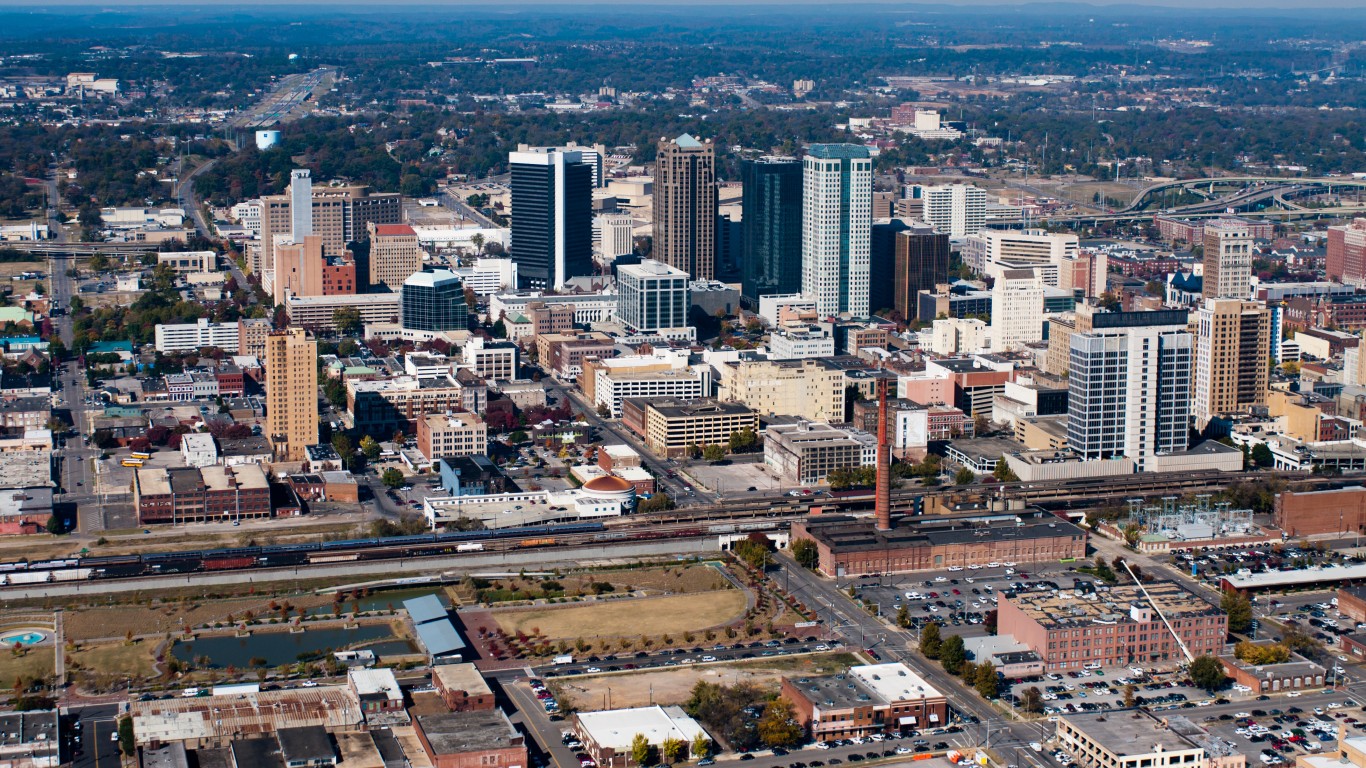
Alabama: Birmingham-Hoover
> Avg. time lost to traffic delays, 2020: 23 hours per commuter
> Incidents of auto theft, 2021: 292 per 100,000 people (226 per 100,000 in state)
> Fatal crash rate, 2020: 17.0 per 100,000 people (16.9 per 100,000 in state)
> Avg. commute time to work in 2021: 26.2 minutes (25.3 minutes in state)
> Metro areas considered in state: 12
[in-text-ad]
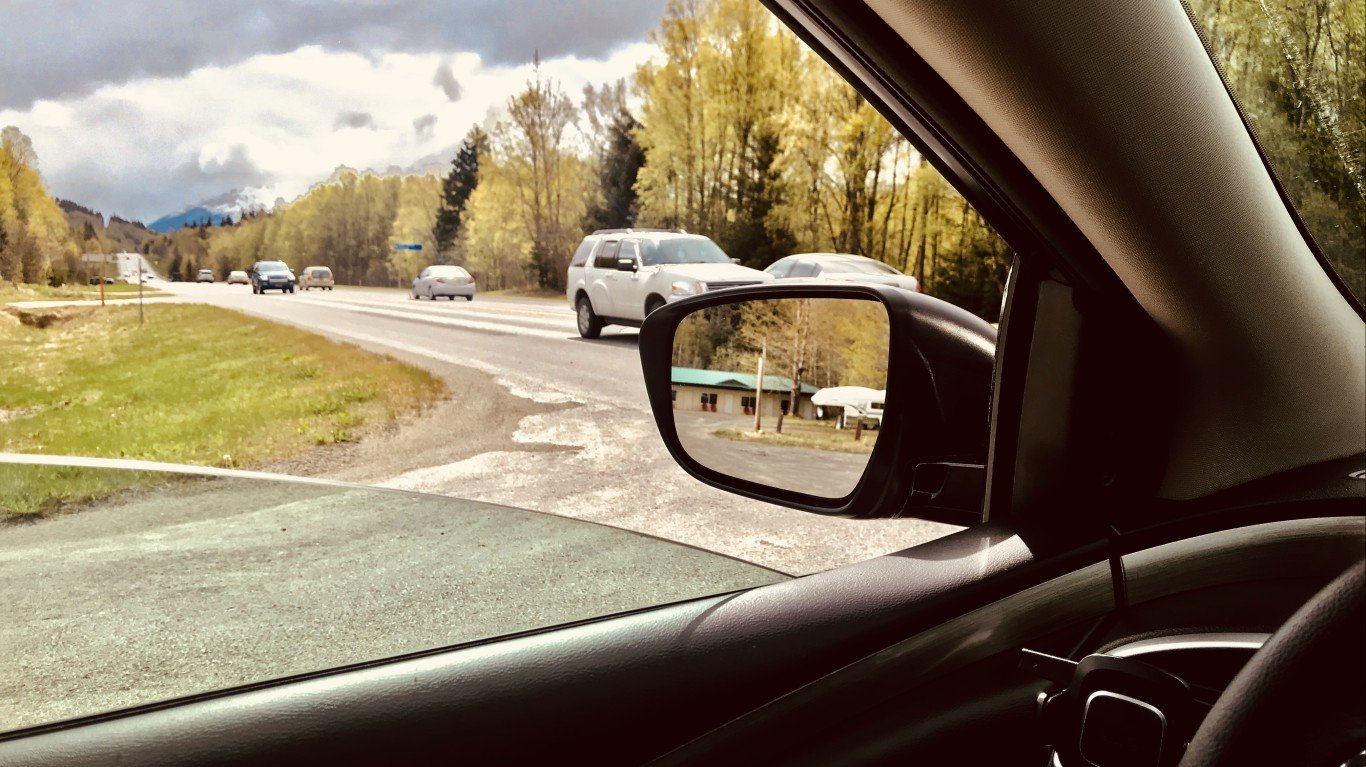
Alaska: Anchorage
> Avg. time lost to traffic delays, 2020: 18 hours per commuter
> Incidents of auto theft, 2021: 331 per 100,000 people (240 per 100,000 in state)
> Fatal crash rate, 2020: 7.0 per 100,000 people (7.2 per 100,000 in state)
> Avg. commute time to work in 2021: 23.0 minutes (19.8 minutes in state)
> Metro areas considered in state: 2
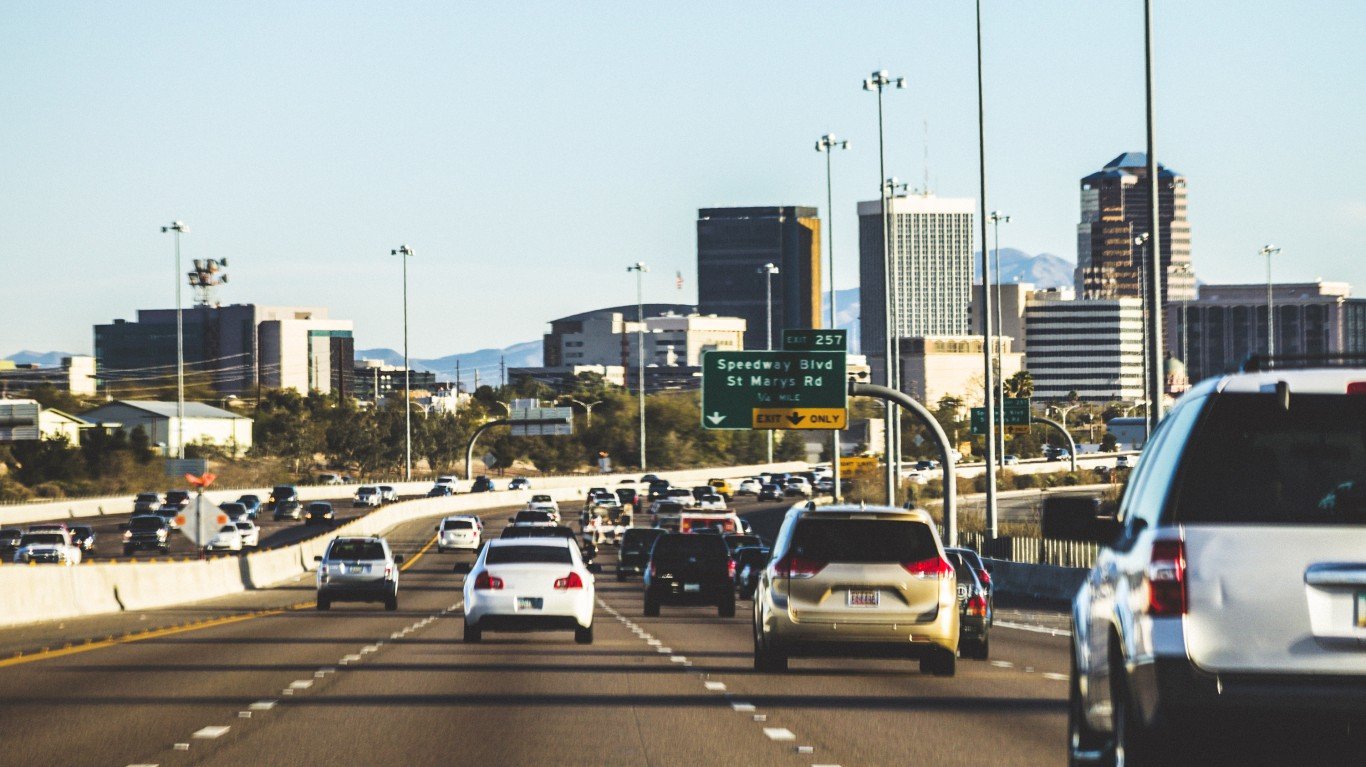
Arizona: Tucson
> Avg. time lost to traffic delays, 2020: 21 hours per commuter
> Incidents of auto theft, 2021: 314 per 100,000 people (284 per 100,000 in state)
> Fatal crash rate, 2020: 14.5 per 100,000 people (13.3 per 100,000 in state)
> Avg. commute time to work in 2021: 24.1 minutes (24.8 minutes in state)
> Metro areas considered in state: 7
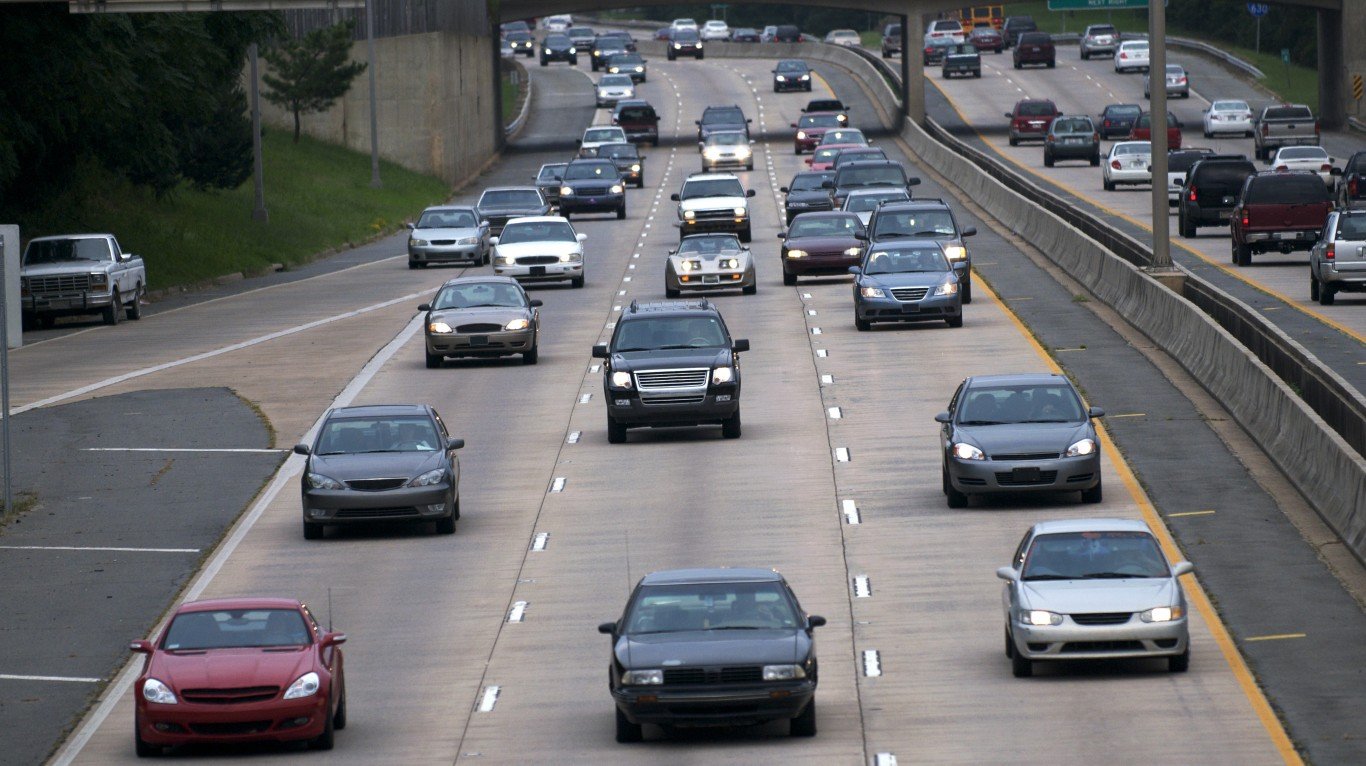
Arkansas: Little Rock-North Little Rock-Conway
> Avg. time lost to traffic delays, 2020: 33 hours per commuter
> Incidents of auto theft, 2021: 423 per 100,000 people (301 per 100,000 in state)
> Fatal crash rate, 2020: 16.1 per 100,000 people (19.3 per 100,000 in state)
> Avg. commute time to work in 2021: 23.1 minutes (22.2 minutes in state)
> Metro areas considered in state: 6
[in-text-ad-2]
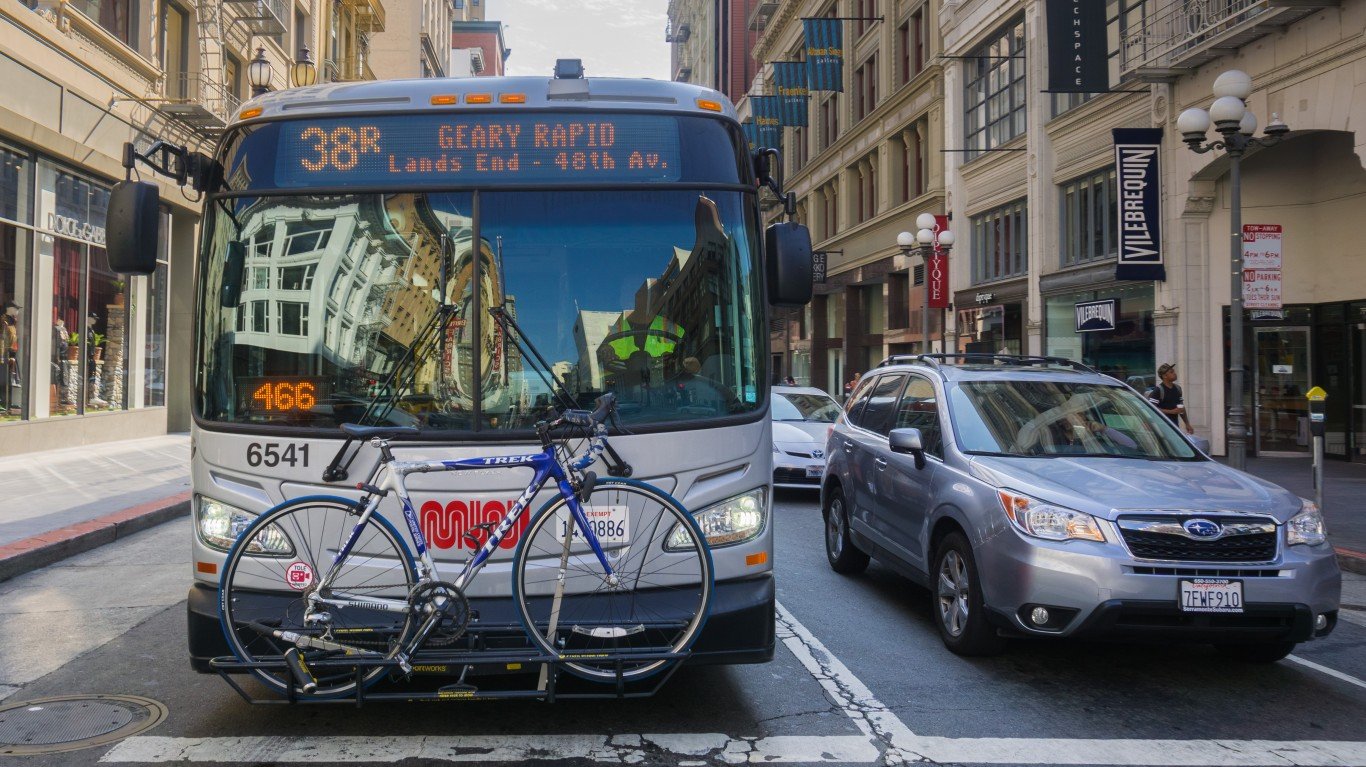
California: San Francisco-Oakland-Berkeley
> Avg. time lost to traffic delays, 2020: 46 hours per commuter
> Incidents of auto theft, 2021: 676 per 100,000 people (511 per 100,000 in state)
> Fatal crash rate, 2020: 5.5 per 100,000 people (9.1 per 100,000 in state)
> Avg. commute time to work in 2021: 28.8 minutes (27.6 minutes in state)
> Metro areas considered in state: 26

Colorado: Denver-Aurora-Lakewood
> Avg. time lost to traffic delays, 2020: 26 hours per commuter
> Incidents of auto theft, 2021: 965 per 100,000 people (661 per 100,000 in state)
> Fatal crash rate, 2020: 7.5 per 100,000 people (9.9 per 100,000 in state)
> Avg. commute time to work in 2021: 26.7 minutes (25.0 minutes in state)
> Metro areas considered in state: 7
[in-text-ad]

Connecticut: Bridgeport-Stamford-Norwalk
> Avg. time lost to traffic delays, 2020: 40 hours per commuter
> Incidents of auto theft, 2021: 207 per 100,000 people (216 per 100,000 in state)
> Fatal crash rate, 2020: 5.9 per 100,000 people (7.7 per 100,000 in state)
> Avg. commute time to work in 2021: 29.1 minutes (25.6 minutes in state)
> Metro areas considered in state: 4
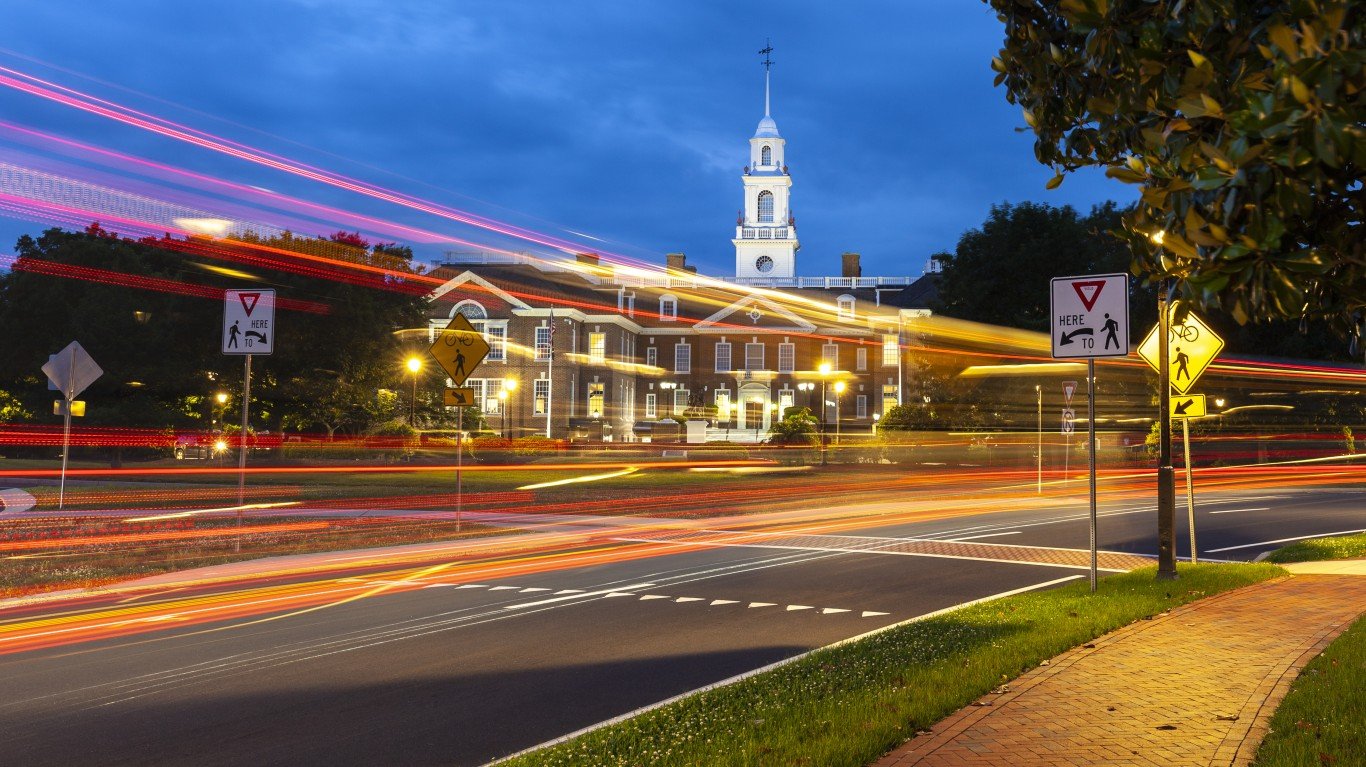
Delaware: Dover*
> Avg. time lost to traffic delays, 2020: 10 hours per commuter
> Incidents of auto theft, 2021: 142 per 100,000 people (187 per 100,000 in state)
> Fatal crash rate, 2020: 8.7 per 100,000 people (10.4 per 100,000 in state)
> Avg. commute time to work in 2021: 25.1 minutes (25.4 minutes in state)
> Metro areas considered in state: 1
*Because Dover is the only eligible metro area in Delaware, it ranks as the worst city to drive in by default.
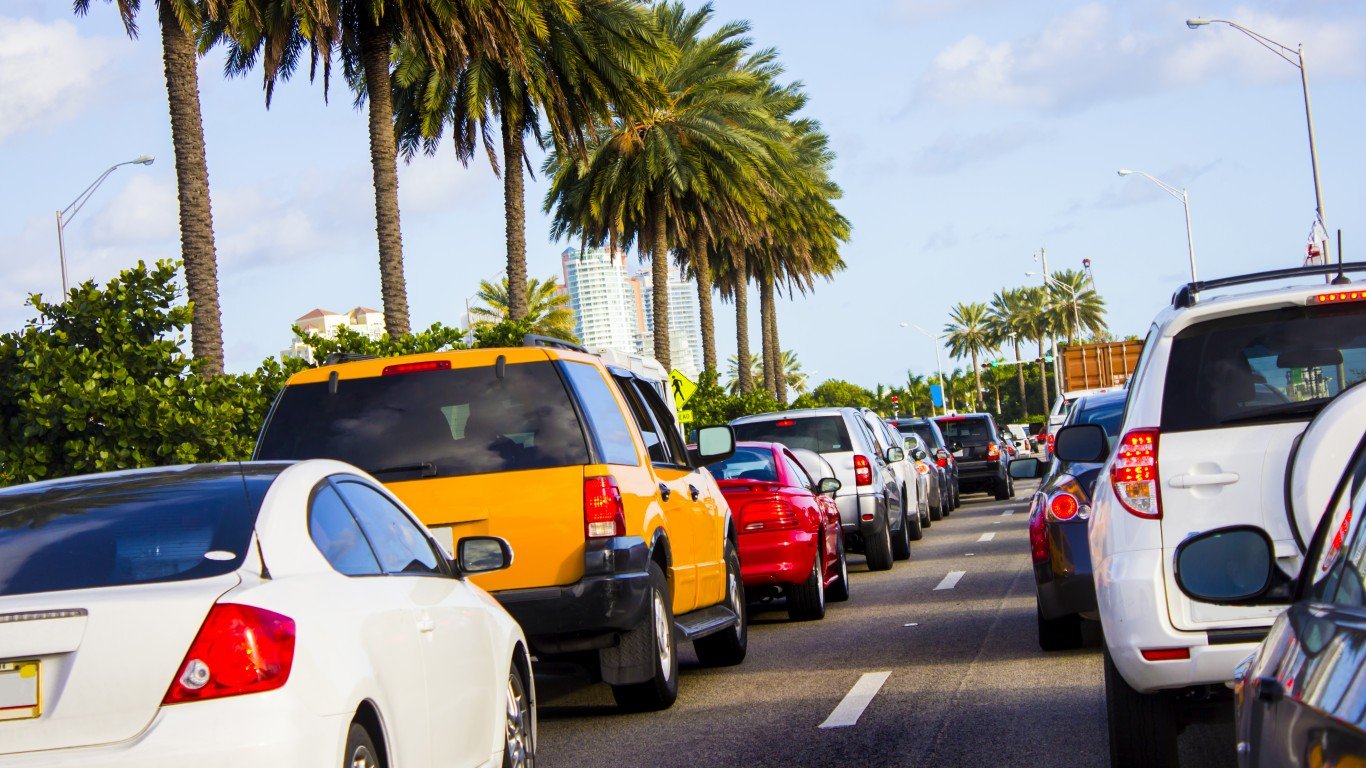
Florida: Miami-Fort Lauderdale-Pompano Beach
> Avg. time lost to traffic delays, 2020: 27 hours per commuter
> Incidents of auto theft, 2021: 279 per 100,000 people (197 per 100,000 in state)
> Fatal crash rate, 2020: 12.0 per 100,000 people (14.2 per 100,000 in state)
> Avg. commute time to work in 2021: 28.3 minutes (27.1 minutes in state)
> Metro areas considered in state: 20
[in-text-ad-2]
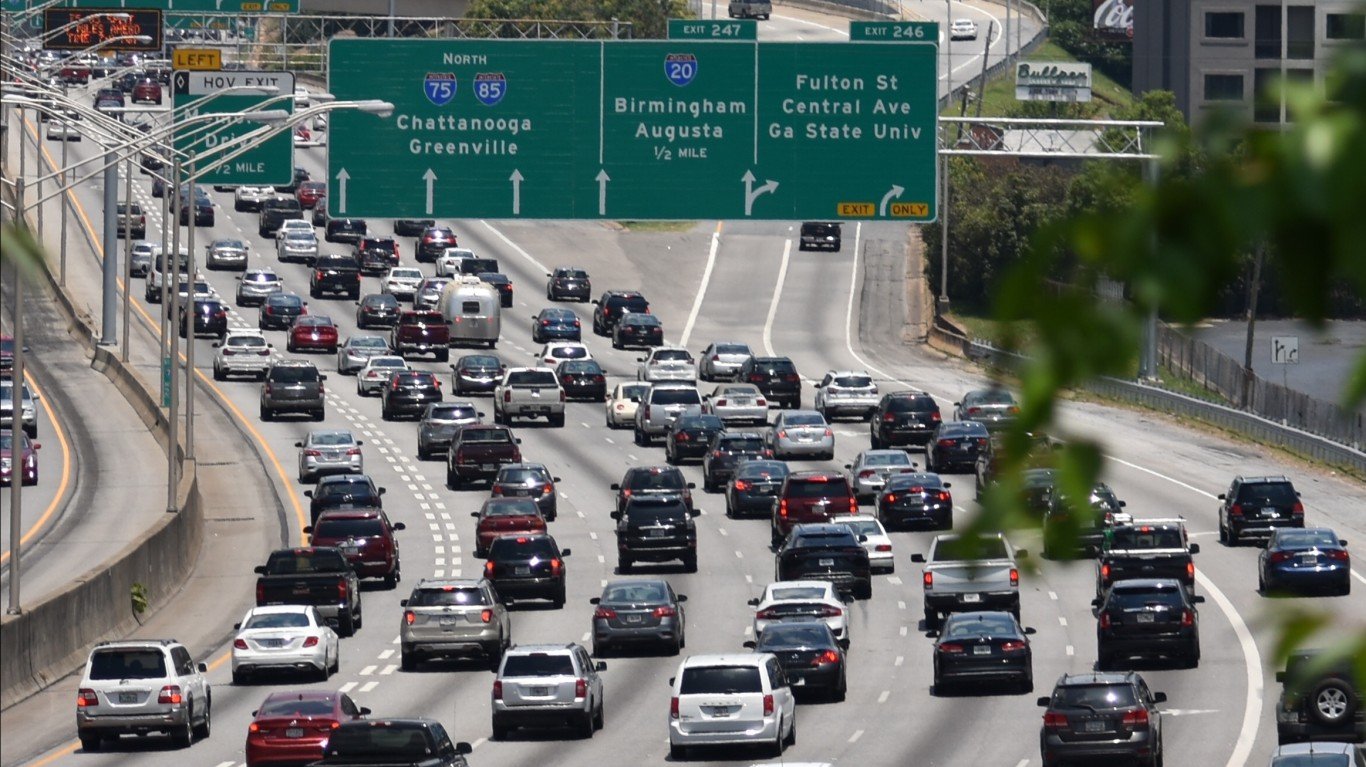
Georgia: Atlanta-Sandy Springs-Alpharetta
> Avg. time lost to traffic delays, 2020: 37 hours per commuter
> Incidents of auto theft, 2021: 271 per 100,000 people (241 per 100,000 in state)
> Fatal crash rate, 2020: 11.2 per 100,000 people (14.1 per 100,000 in state)
> Avg. commute time to work in 2021: 29.6 minutes (27.1 minutes in state)
> Metro areas considered in state: 14

Hawaii: Urban Honolulu
> Avg. time lost to traffic delays, 2020: 24 hours per commuter
> Incidents of auto theft, 2021: 331 per 100,000 people (230 per 100,000 in state)
> Fatal crash rate, 2020: 4.9 per 100,000 people (5.6 per 100,000 in state)
> Avg. commute time to work in 2021: 25.8 minutes (25.3 minutes in state)
> Metro areas considered in state: 2
[in-text-ad]

Idaho: Boise City
> Avg. time lost to traffic delays, 2020: 18 hours per commuter
> Incidents of auto theft, 2021: 94 per 100,000 people (97 per 100,000 in state)
> Fatal crash rate, 2020: 6.4 per 100,000 people (9.9 per 100,000 in state)
> Avg. commute time to work in 2021: 22.7 minutes (21.6 minutes in state)
> Metro areas considered in state: 5
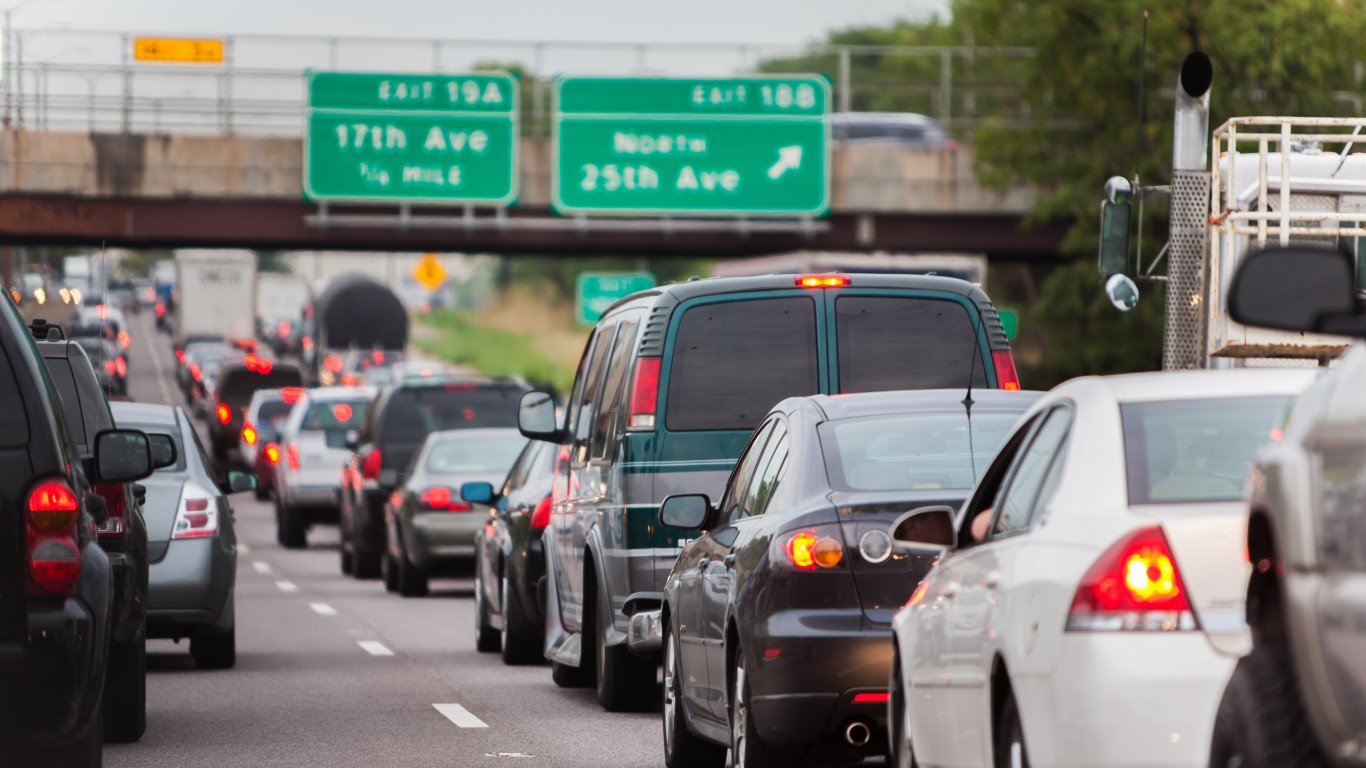
Illinois: Chicago-Naperville-Elgin
> Avg. time lost to traffic delays, 2020: 39 hours per commuter
> Incidents of auto theft, 2021: 247 per 100,000 people (225 per 100,000 in state)
> Fatal crash rate, 2020: 6.8 per 100,000 people (8.6 per 100,000 in state)
> Avg. commute time to work in 2021: 29.0 minutes (26.8 minutes in state)
> Metro areas considered in state: 10
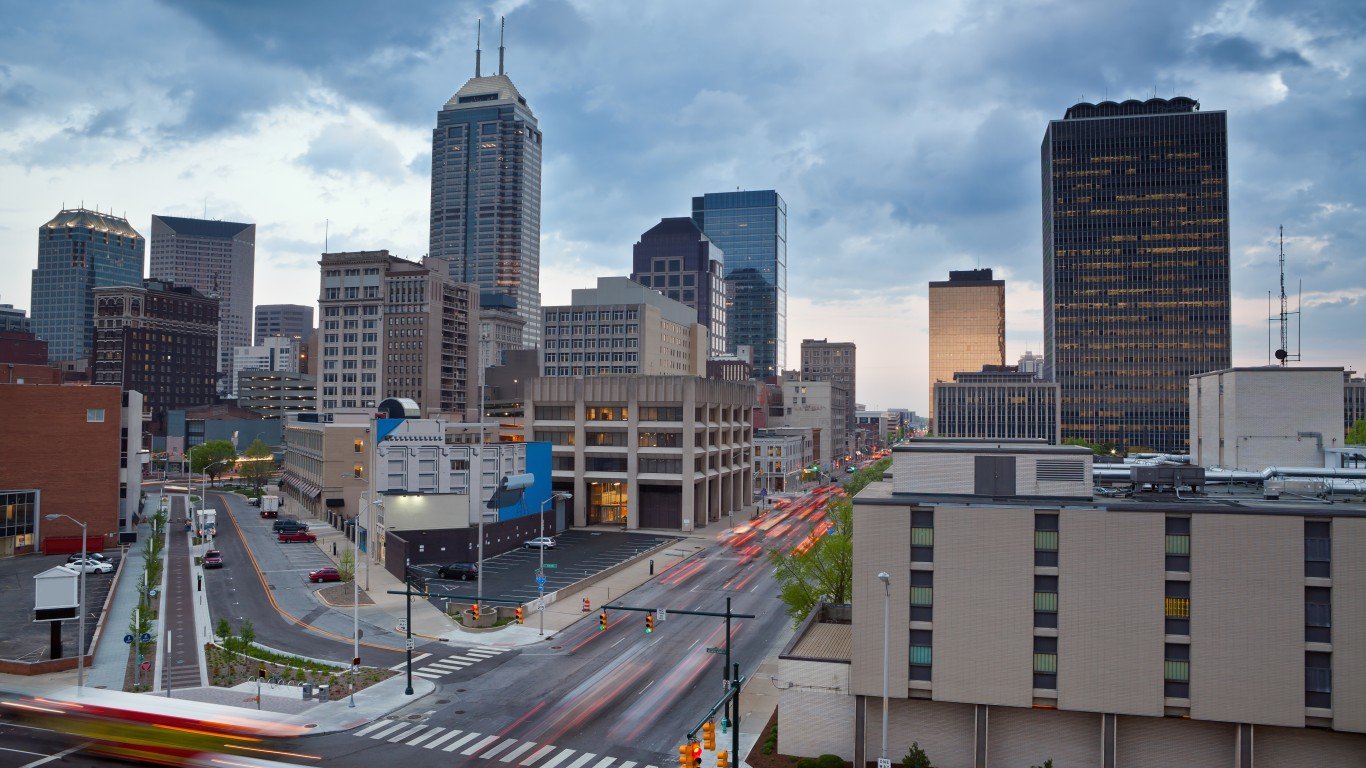
Indiana: Indianapolis-Carmel-Anderson
> Avg. time lost to traffic delays, 2020: 26 hours per commuter
> Incidents of auto theft, 2021: 360 per 100,000 people (236 per 100,000 in state)
> Fatal crash rate, 2020: 11.0 per 100,000 people (12.0 per 100,000 in state)
> Avg. commute time to work in 2021: 24.9 minutes (23.8 minutes in state)
> Metro areas considered in state: 12
[in-text-ad-2]

Iowa: Davenport-Moline-Rock Island
> Avg. time lost to traffic delays, 2020: 9 hours per commuter
> Incidents of auto theft, 2021: 319 per 100,000 people (185 per 100,000 in state)
> Fatal crash rate, 2020: 8.1 per 100,000 people (9.5 per 100,000 in state)
> Avg. commute time to work in 2021: 21.6 minutes (19.7 minutes in state)
> Metro areas considered in state: 8

Kansas: Wichita
> Avg. time lost to traffic delays, 2020: 25 hours per commuter
> Incidents of auto theft, 2021: 479 per 100,000 people (312 per 100,000 in state)
> Fatal crash rate, 2020: 12.0 per 100,000 people (13.0 per 100,000 in state)
> Avg. commute time to work in 2021: 20.1 minutes (19.6 minutes in state)
> Metro areas considered in state: 4
[in-text-ad]
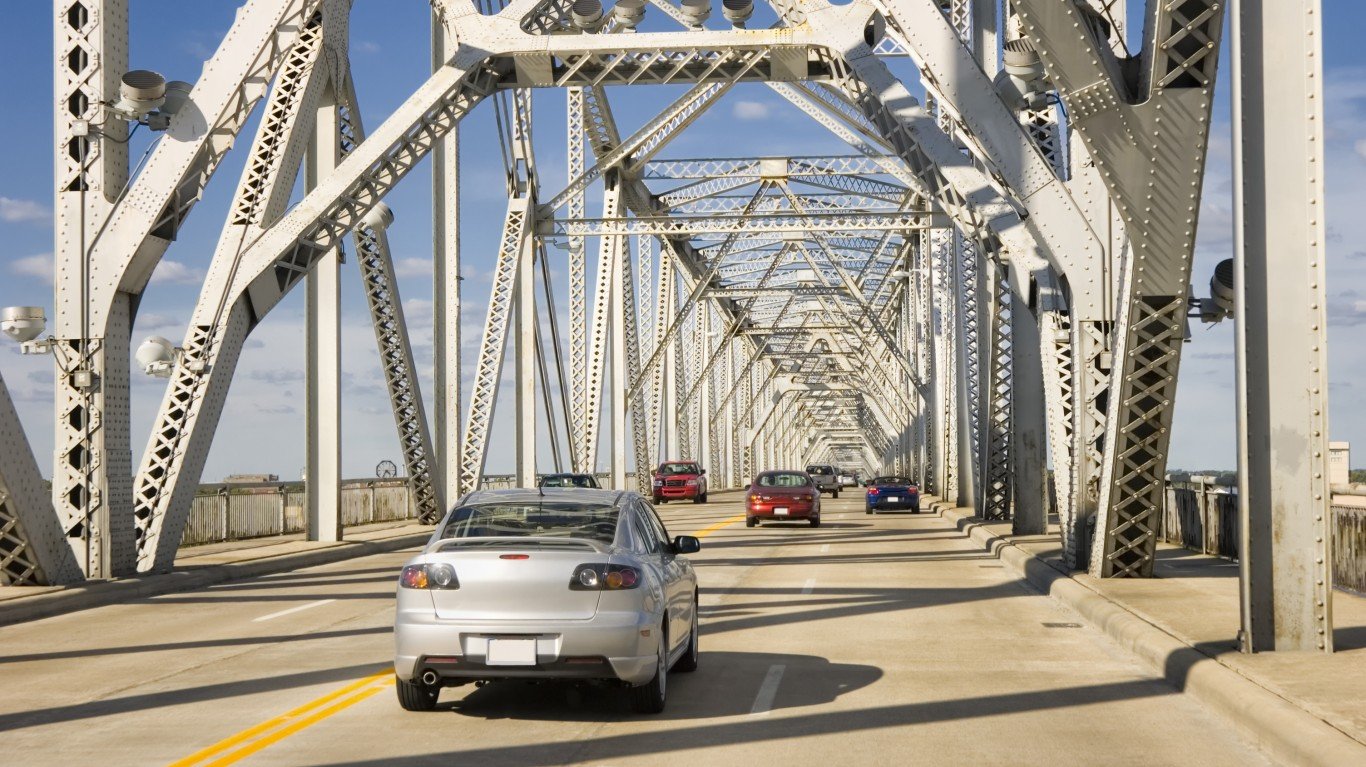
Kentucky: Louisville/Jefferson County
> Avg. time lost to traffic delays, 2020: 22 hours per commuter
> Incidents of auto theft, 2021: 457 per 100,000 people (237 per 100,000 in state)
> Fatal crash rate, 2020: 14.6 per 100,000 people (15.7 per 100,000 in state)
> Avg. commute time to work in 2021: 22.8 minutes (23.6 minutes in state)
> Metro areas considered in state: 5
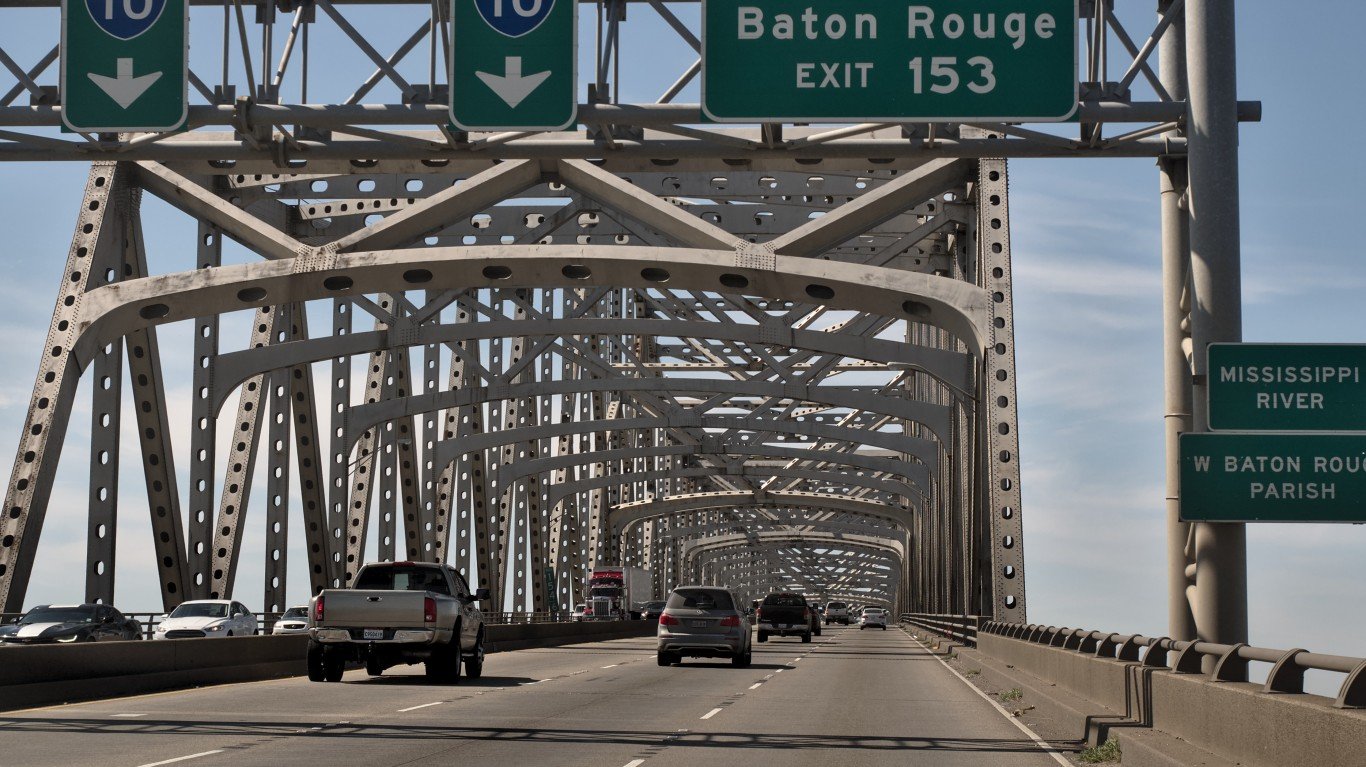
Louisiana: Baton Rouge
> Avg. time lost to traffic delays, 2020: 24 hours per commuter
> Incidents of auto theft, 2021: 253 per 100,000 people (281 per 100,000 in state)
> Fatal crash rate, 2020: 19.4 per 100,000 people (16.5 per 100,000 in state)
> Avg. commute time to work in 2021: 27.6 minutes (25.5 minutes in state)
> Metro areas considered in state: 9

Maine: Bangor
> Avg. time lost to traffic delays, 2020: 14 hours per commuter
> Incidents of auto theft, 2021: 96 per 100,000 people (61 per 100,000 in state)
> Fatal crash rate, 2020: 11.8 per 100,000 people (11.0 per 100,000 in state)
> Avg. commute time to work in 2021: 23.3 minutes (24.2 minutes in state)
> Metro areas considered in state: 3
[in-text-ad-2]
Maryland: Baltimore-Columbia-Towson
> Avg. time lost to traffic delays, 2020: 27 hours per commuter
> Incidents of auto theft, 2021: 238 per 100,000 people (223 per 100,000 in state)
> Fatal crash rate, 2020: 8.1 per 100,000 people (8.8 per 100,000 in state)
> Avg. commute time to work in 2021: 27.7 minutes (29.3 minutes in state)
> Metro areas considered in state: 5
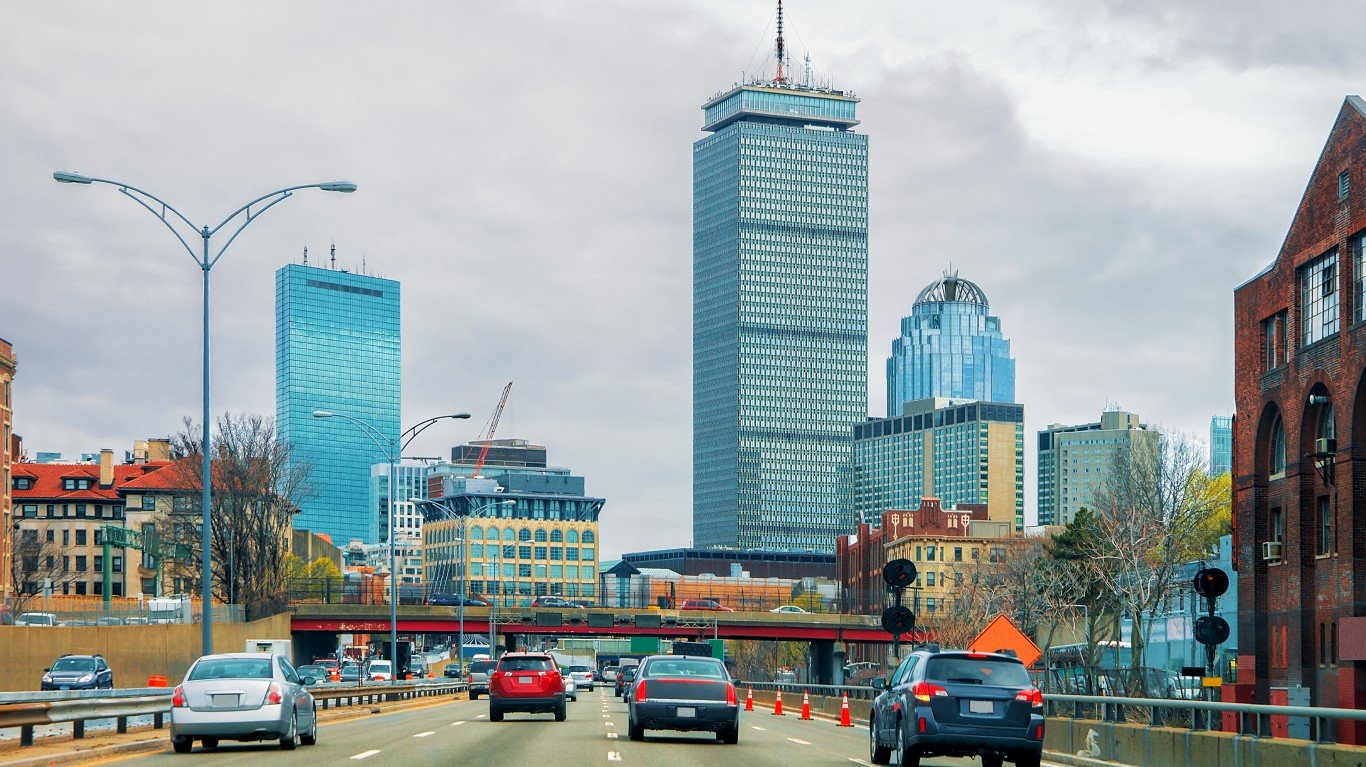
Massachusetts: Boston-Cambridge-Newton
> Avg. time lost to traffic delays, 2020: 50 hours per commuter
> Incidents of auto theft, 2021: 97 per 100,000 people (100 per 100,000 in state)
> Fatal crash rate, 2020: 4.1 per 100,000 people (4.7 per 100,000 in state)
> Avg. commute time to work in 2021: 28.4 minutes (27.5 minutes in state)
> Metro areas considered in state: 5
[in-text-ad]
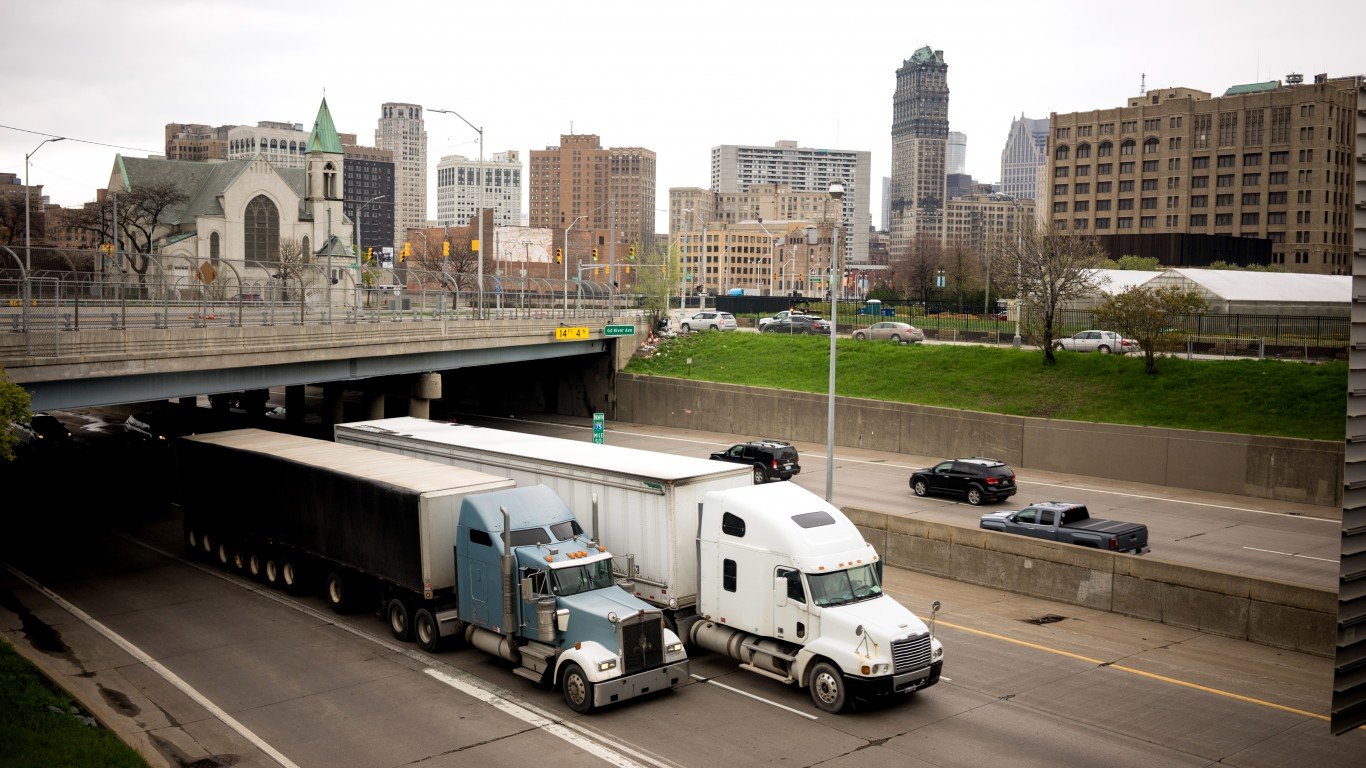
Michigan: Detroit-Warren-Dearborn
> Avg. time lost to traffic delays, 2020: 35 hours per commuter
> Incidents of auto theft, 2021: 290 per 100,000 people (212 per 100,000 in state)
> Fatal crash rate, 2020: 8.7 per 100,000 people (10.1 per 100,000 in state)
> Avg. commute time to work in 2021: 25.4 minutes (23.8 minutes in state)
> Metro areas considered in state: 13
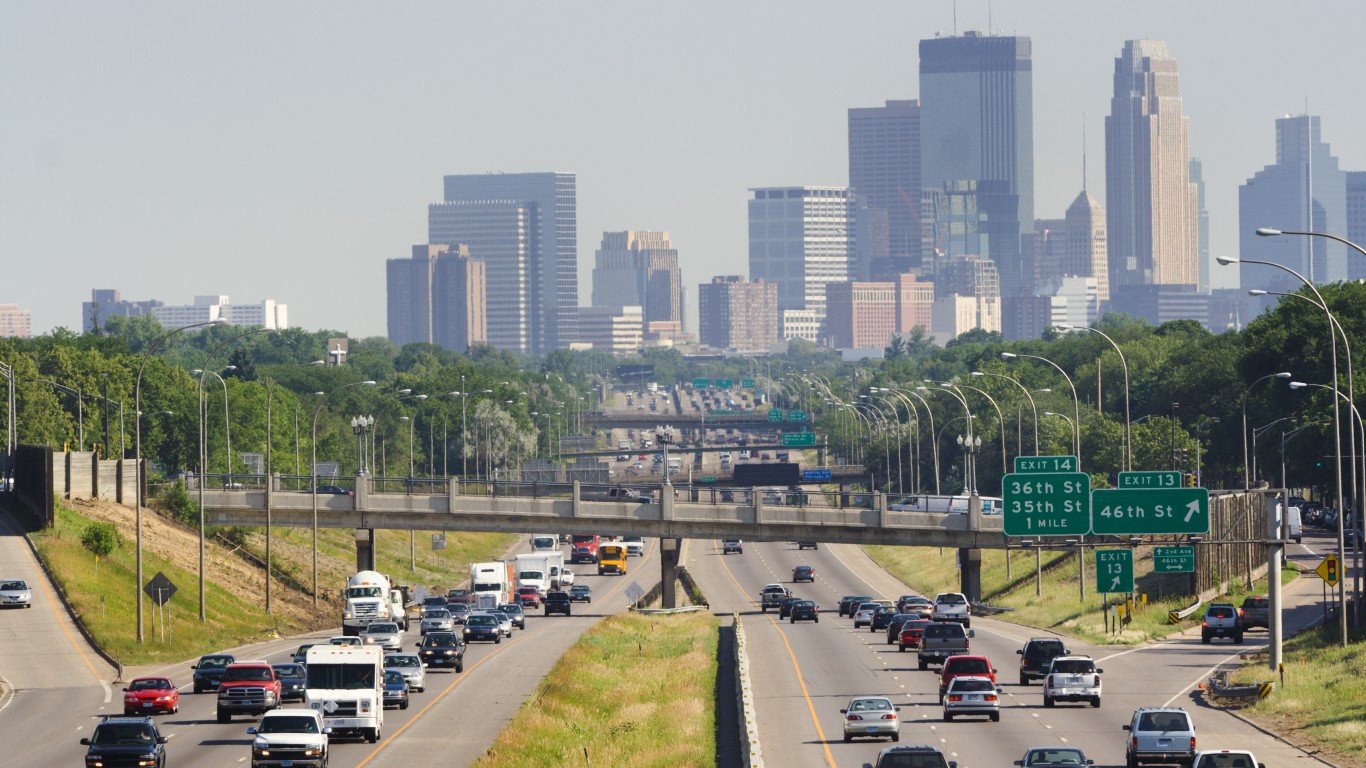
Minnesota: Minneapolis-St. Paul-Bloomington
> Avg. time lost to traffic delays, 2020: 32 hours per commuter
> Incidents of auto theft, 2021: 380 per 100,000 people (297 per 100,000 in state)
> Fatal crash rate, 2020: 4.4 per 100,000 people (6.5 per 100,000 in state)
> Avg. commute time to work in 2021: 23.3 minutes (22.2 minutes in state)
> Metro areas considered in state: 5

Mississippi: Jackson
> Avg. time lost to traffic delays, 2020: 29 hours per commuter
> Incidents of auto theft, 2021: 295 per 100,000 people (217 per 100,000 in state)
> Fatal crash rate, 2020: 19.6 per 100,000 people (23.3 per 100,000 in state)
> Avg. commute time to work in 2021: 25.2 minutes (25.2 minutes in state)
> Metro areas considered in state: 3
[in-text-ad-2]
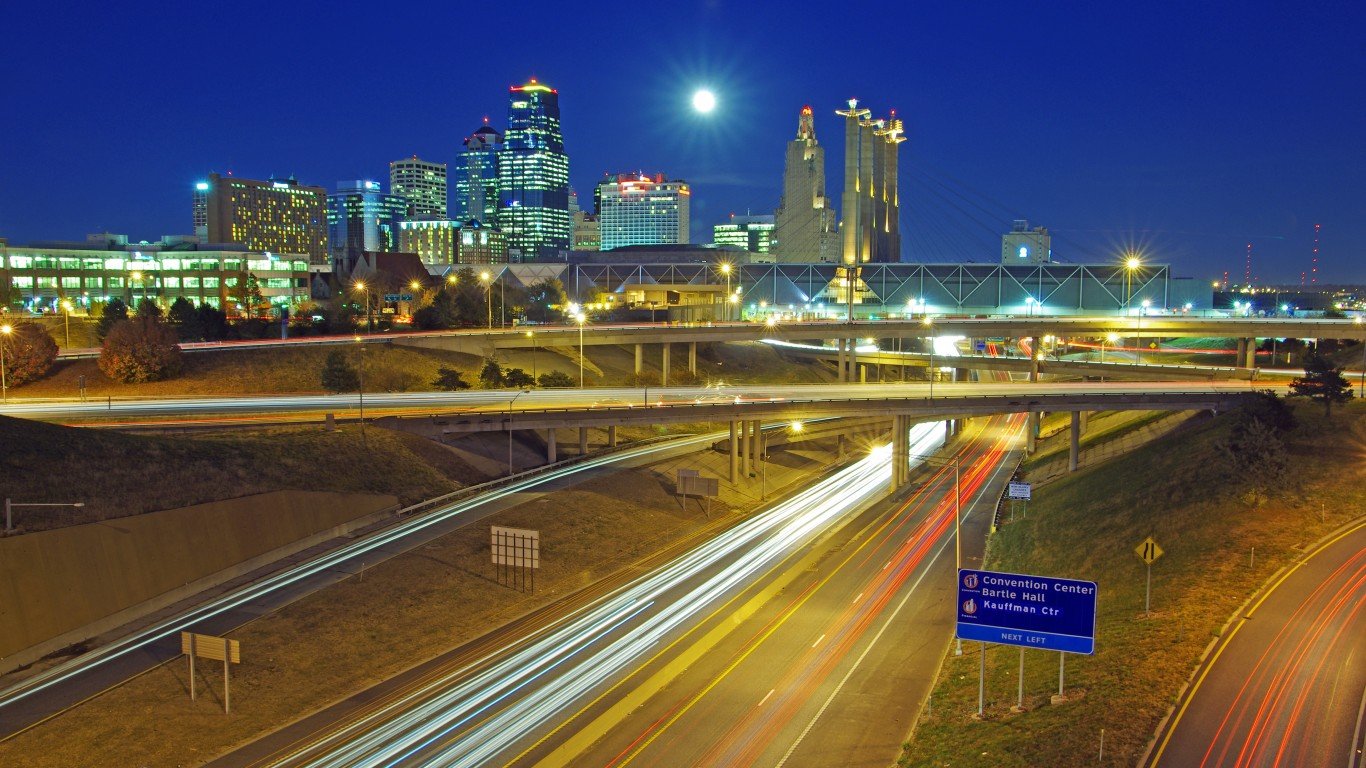
Missouri: Kansas City
> Avg. time lost to traffic delays, 2020: 34 hours per commuter
> Incidents of auto theft, 2021: 530 per 100,000 people (428 per 100,000 in state)
> Fatal crash rate, 2020: 10.9 per 100,000 people (14.8 per 100,000 in state)
> Avg. commute time to work in 2021: 23.0 minutes (23.1 minutes in state)
> Metro areas considered in state: 8
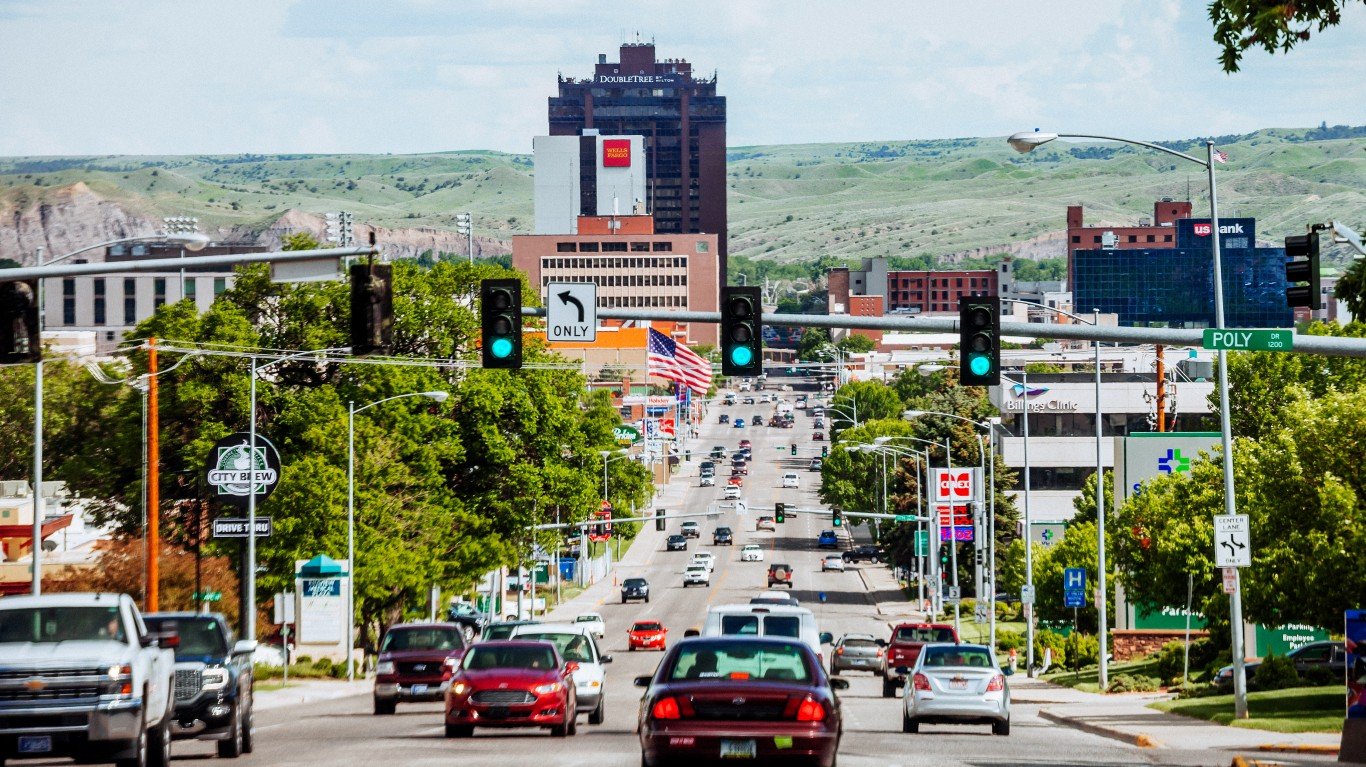
Montana: Billings
> Avg. time lost to traffic delays, 2020: 9 hours per commuter
> Incidents of auto theft, 2021: 611 per 100,000 people (264 per 100,000 in state)
> Fatal crash rate, 2020: 11.2 per 100,000 people (17.2 per 100,000 in state)
> Avg. commute time to work in 2021: 19.9 minutes (19.1 minutes in state)
> Metro areas considered in state: 3
[in-text-ad]
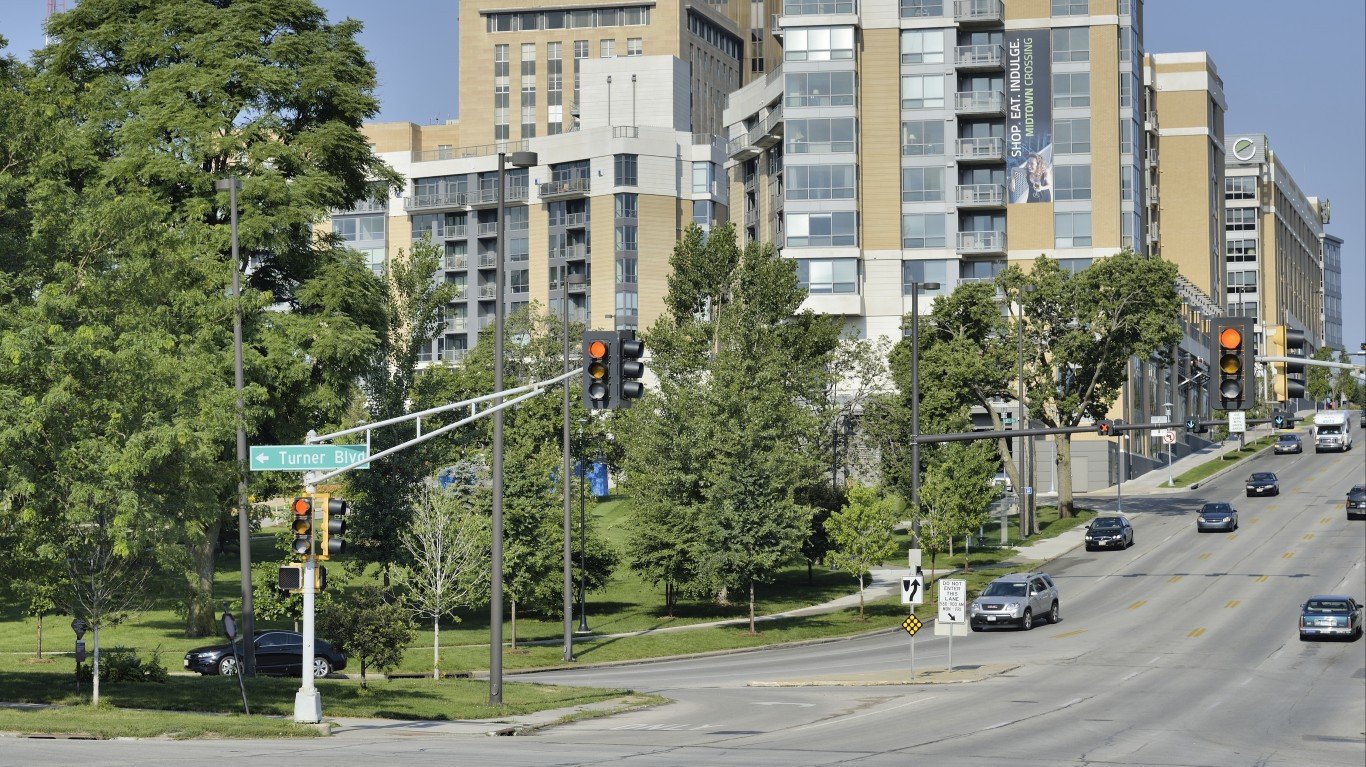
Nebraska: Omaha-Council Bluffs
> Avg. time lost to traffic delays, 2020: 19 hours per commuter
> Incidents of auto theft, 2021: 394 per 100,000 people (237 per 100,000 in state)
> Fatal crash rate, 2020: 8.2 per 100,000 people (11.1 per 100,000 in state)
> Avg. commute time to work in 2021: 20.8 minutes (19.3 minutes in state)
> Metro areas considered in state: 3

Nevada: Las Vegas-Henderson-Paradise
> Avg. time lost to traffic delays, 2020: 18 hours per commuter
> Incidents of auto theft, 2021: 476 per 100,000 people (427 per 100,000 in state)
> Fatal crash rate, 2020: 7.6 per 100,000 people (9.3 per 100,000 in state)
> Avg. commute time to work in 2021: 24.4 minutes (24.6 minutes in state)
> Metro areas considered in state: 3

New Hampshire: Manchester-Nashua*
> Avg. time lost to traffic delays, 2020: 13 hours per commuter
> Incidents of auto theft, 2021: 82 per 100,000 people (62 per 100,000 in state)
> Fatal crash rate, 2020: 4.5 per 100,000 people (7.1 per 100,000 in state)
> Avg. commute time to work in 2021: 25.7 minutes (25.7 minutes in state)
> Metro areas considered in state: 1
*Because Manchester-Nashua is the only eligible metro area in New Hampshire, it ranks as the worst city to drive in by default.
[in-text-ad-2]
New Jersey: Atlantic City-Hammonton
> Avg. time lost to traffic delays, 2020: 16 hours per commuter
> Incidents of auto theft, 2021: 168 per 100,000 people (160 per 100,000 in state)
> Fatal crash rate, 2020: 13.8 per 100,000 people (5.9 per 100,000 in state)
> Avg. commute time to work in 2021: 25.7 minutes (28.6 minutes in state)
> Metro areas considered in state: 3
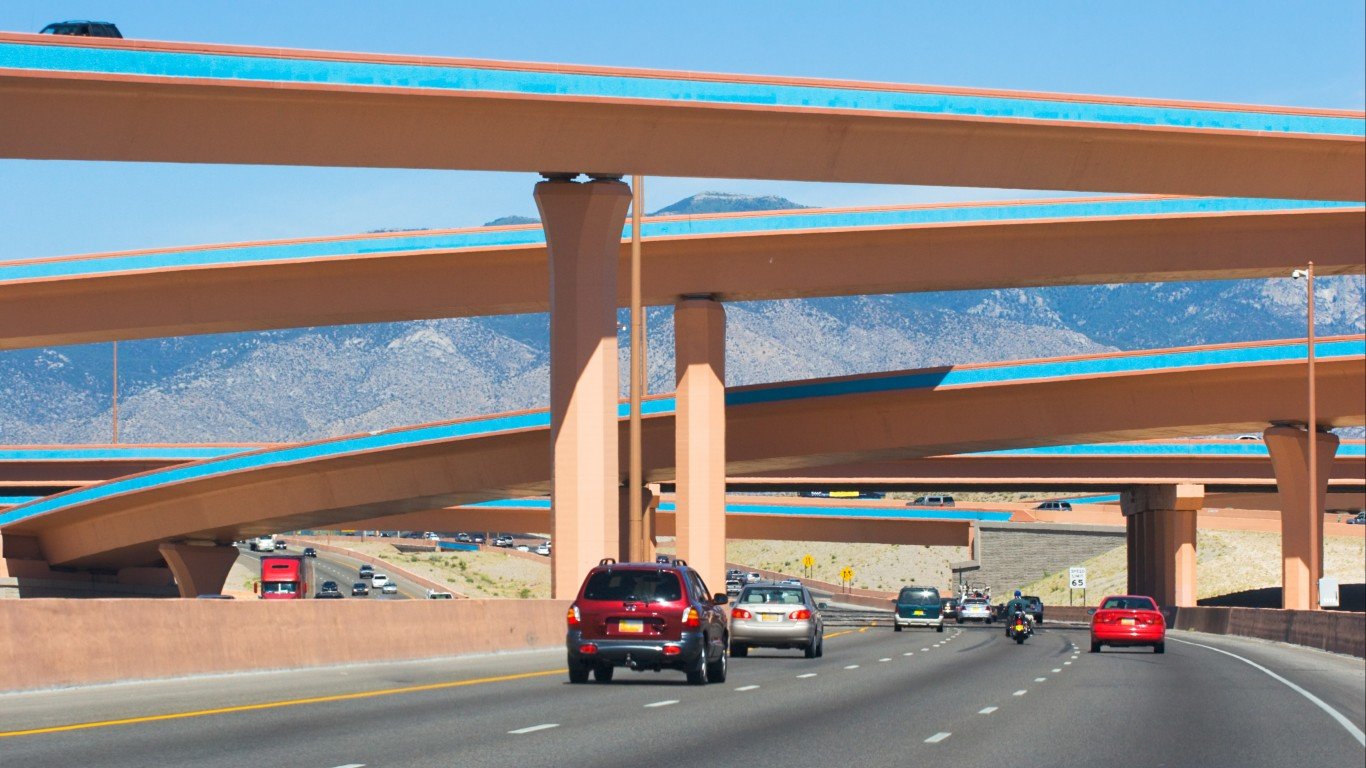
New Mexico: Albuquerque
> Avg. time lost to traffic delays, 2020: 22 hours per commuter
> Incidents of auto theft, 2021: 711 per 100,000 people (476 per 100,000 in state)
> Fatal crash rate, 2020: 14.3 per 100,000 people (17.3 per 100,000 in state)
> Avg. commute time to work in 2021: 24.7 minutes (23.2 minutes in state)
> Metro areas considered in state: 4
[in-text-ad]
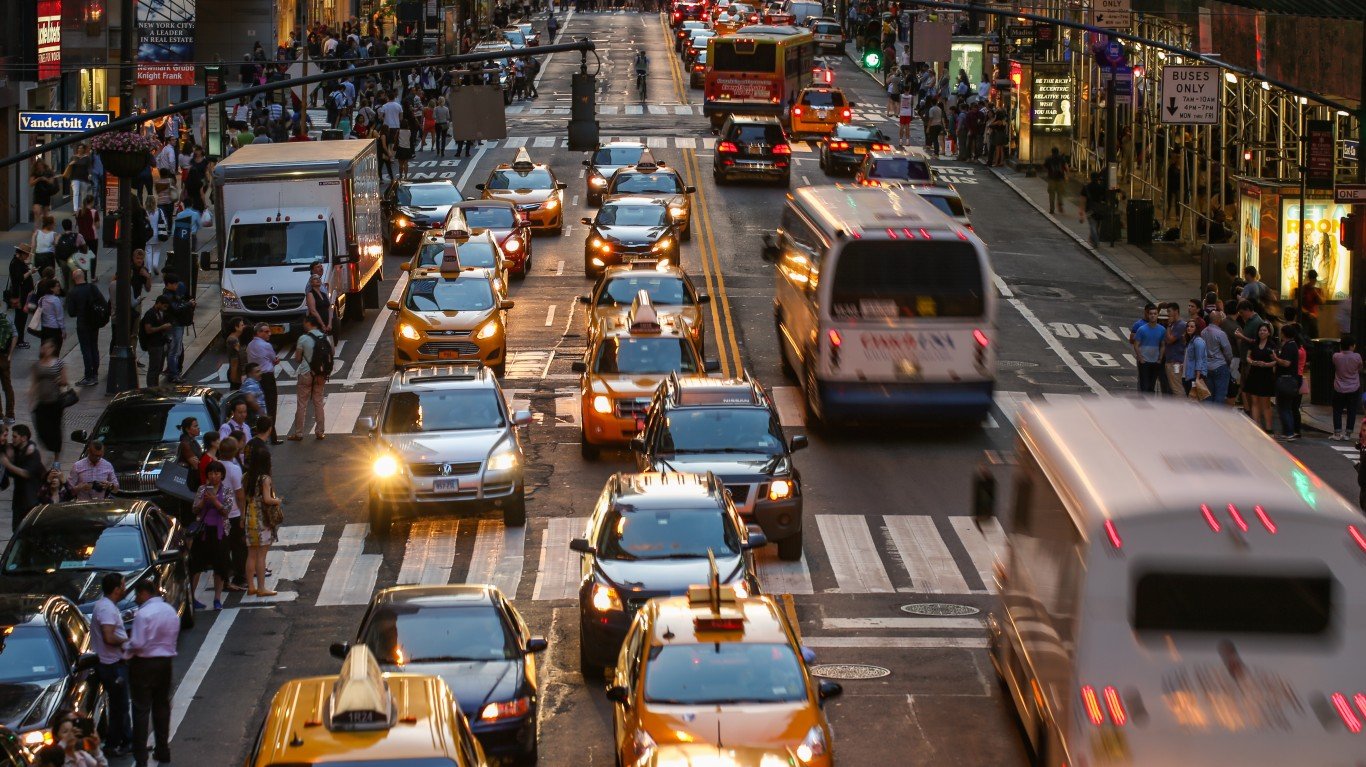
New York: New York-Newark-Jersey City
> Avg. time lost to traffic delays, 2020: 56 hours per commuter
> Incidents of auto theft, 2021: 132 per 100,000 people (116 per 100,000 in state)
> Fatal crash rate, 2020: 4.0 per 100,000 people (4.9 per 100,000 in state)
> Avg. commute time to work in 2021: 34.2 minutes (31.4 minutes in state)
> Metro areas considered in state: 13
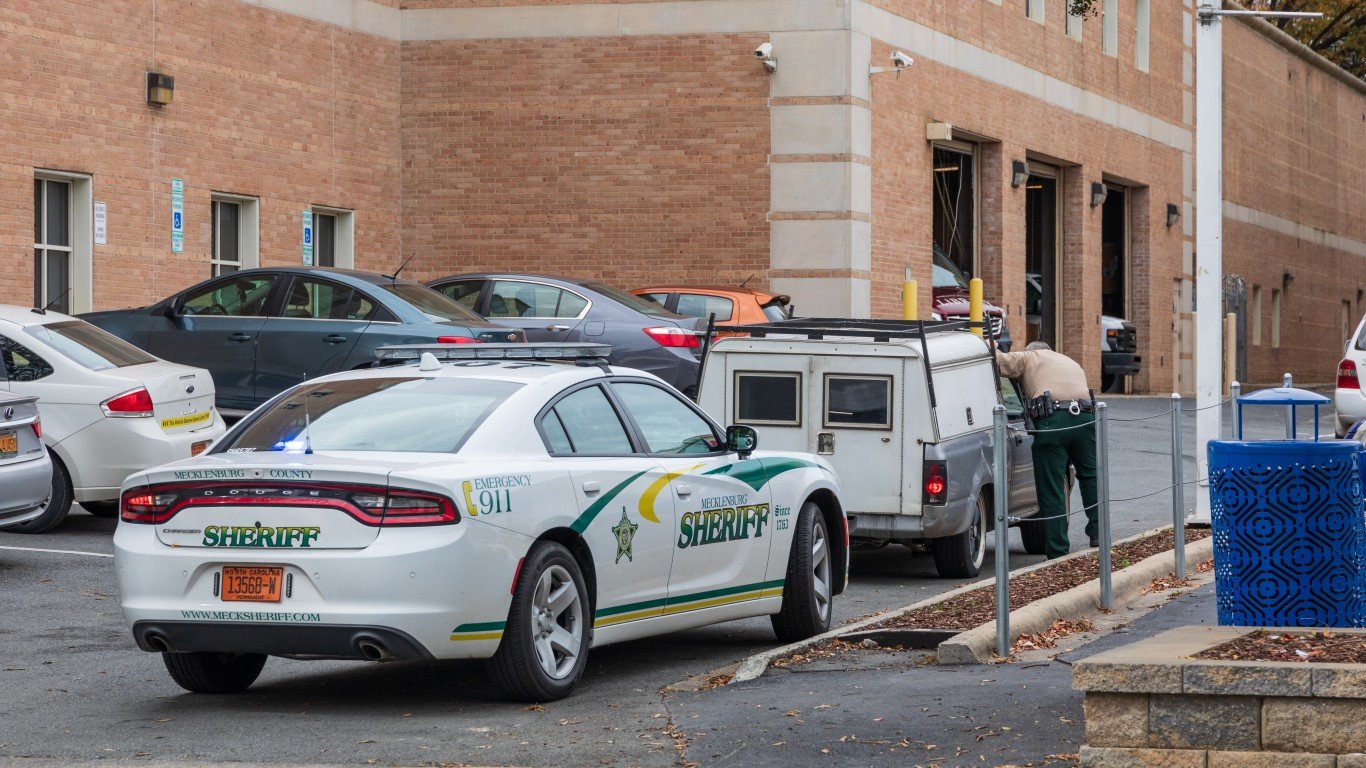
North Carolina: Charlotte-Concord-Gastonia
> Avg. time lost to traffic delays, 2020: 24 hours per commuter
> Incidents of auto theft, 2021: 258 per 100,000 people (213 per 100,000 in state)
> Fatal crash rate, 2020: 10.6 per 100,000 people (13.4 per 100,000 in state)
> Avg. commute time to work in 2021: 25.7 minutes (24.5 minutes in state)
> Metro areas considered in state: 15

North Dakota: Bismarck
> Avg. time lost to traffic delays, 2020: 10 hours per commuter
> Incidents of auto theft, 2021: 224 per 100,000 people (224 per 100,000 in state)
> Fatal crash rate, 2020: 11.9 per 100,000 people (12.4 per 100,000 in state)
> Avg. commute time to work in 2021: 16.4 minutes (17.5 minutes in state)
> Metro areas considered in state: 3
[in-text-ad-2]
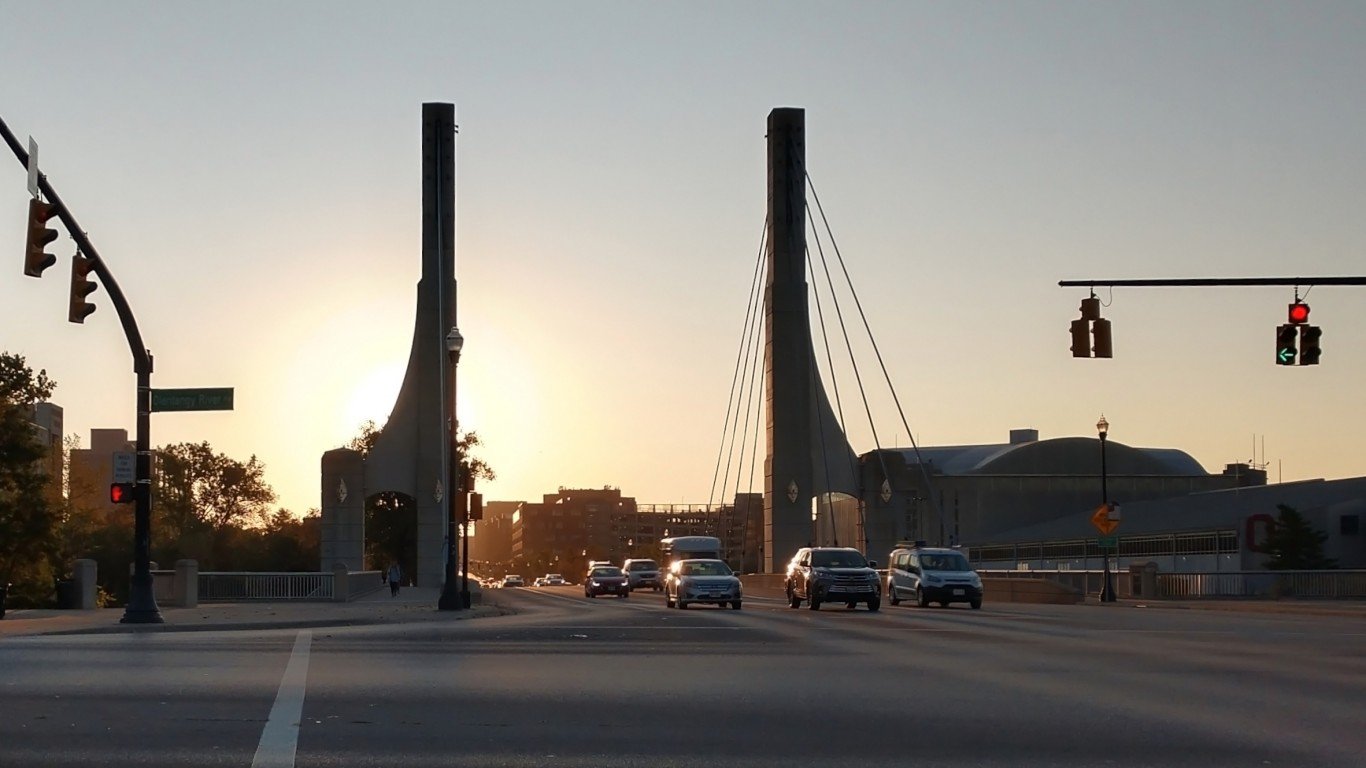
Ohio: Columbus
> Avg. time lost to traffic delays, 2020: 27 hours per commuter
> Incidents of auto theft, 2021: 368 per 100,000 people (236 per 100,000 in state)
> Fatal crash rate, 2020: 9.4 per 100,000 people (9.8 per 100,000 in state)
> Avg. commute time to work in 2021: 23.7 minutes (23.1 minutes in state)
> Metro areas considered in state: 12
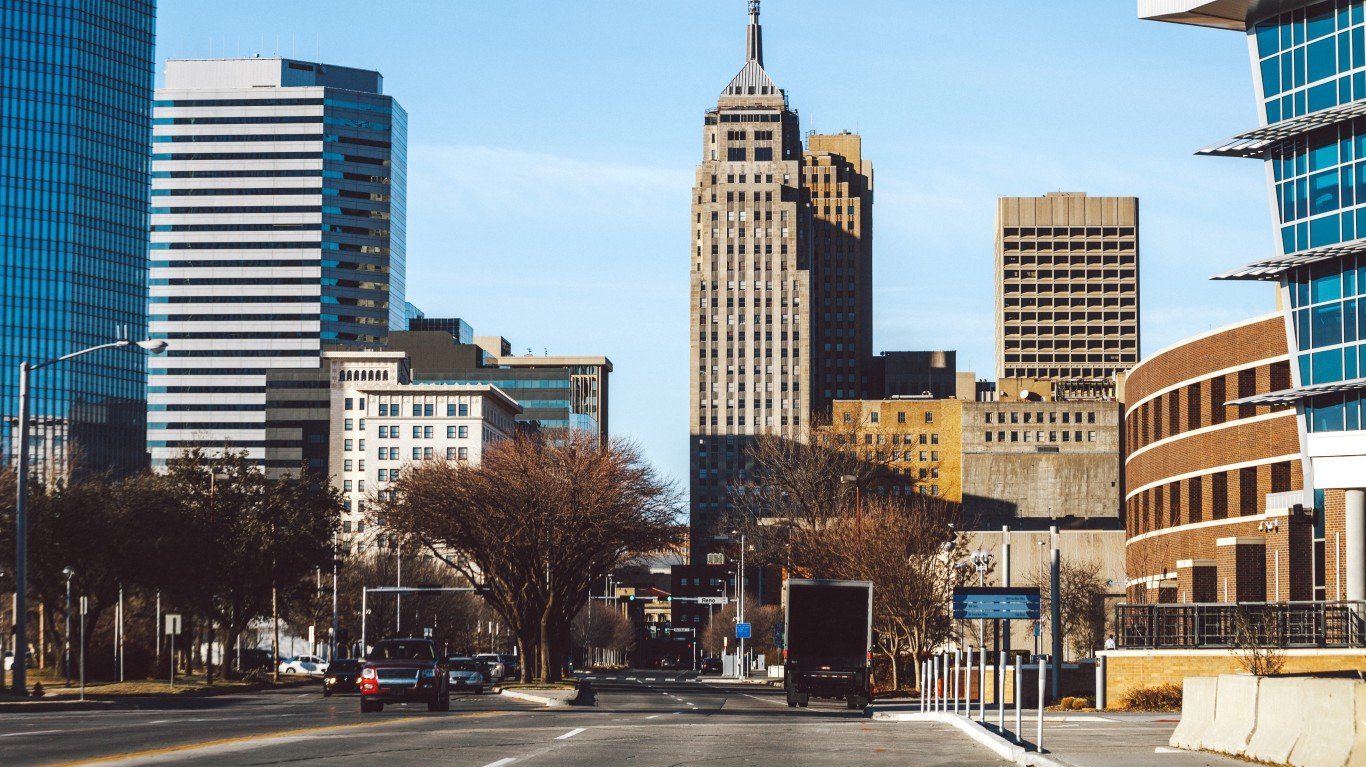
Oklahoma: Oklahoma City
> Avg. time lost to traffic delays, 2020: 35 hours per commuter
> Incidents of auto theft, 2021: 345 per 100,000 people (359 per 100,000 in state)
> Fatal crash rate, 2020: 11.4 per 100,000 people (15.0 per 100,000 in state)
> Avg. commute time to work in 2021: 23.3 minutes (22.0 minutes in state)
> Metro areas considered in state: 3
[in-text-ad]
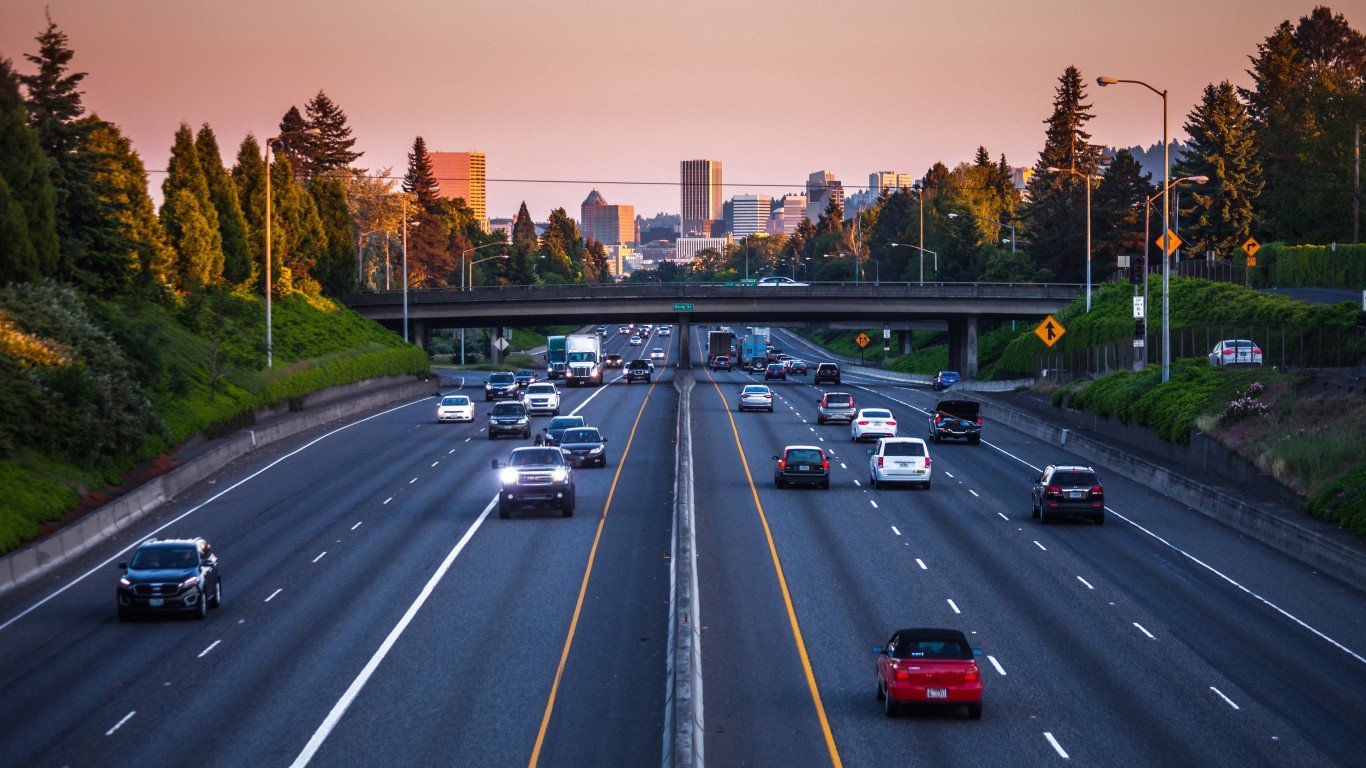
Oregon: Portland-Vancouver-Hillsboro
> Avg. time lost to traffic delays, 2020: 31 hours per commuter
> Incidents of auto theft, 2021: 680 per 100,000 people (471 per 100,000 in state)
> Fatal crash rate, 2020: 7.2 per 100,000 people (10.9 per 100,000 in state)
> Avg. commute time to work in 2021: 24.6 minutes (22.6 minutes in state)
> Metro areas considered in state: 8
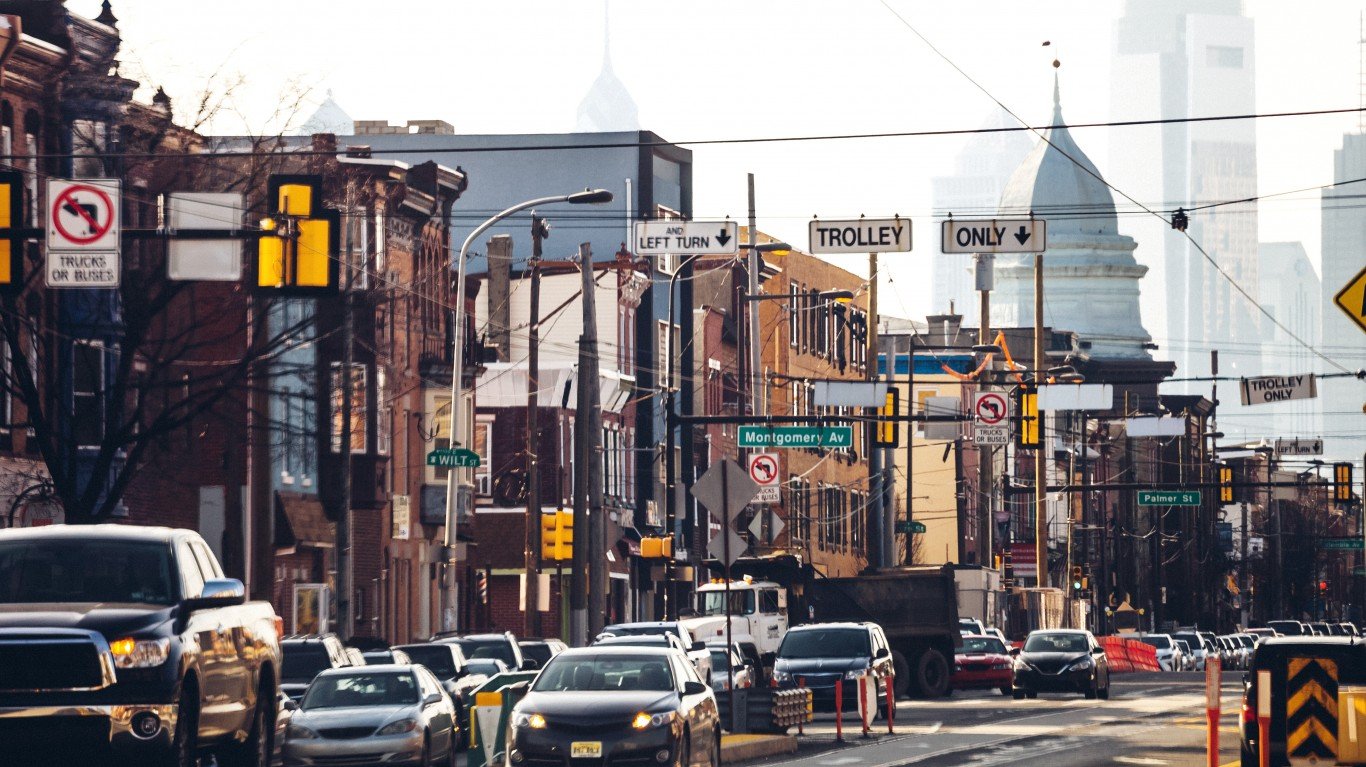
Pennsylvania: Philadelphia-Camden-Wilmington
> Avg. time lost to traffic delays, 2020: 37 hours per commuter
> Incidents of auto theft, 2021: 247 per 100,000 people (139 per 100,000 in state)
> Fatal crash rate, 2020: 7.8 per 100,000 people (8.2 per 100,000 in state)
> Avg. commute time to work in 2021: 27.6 minutes (25.7 minutes in state)
> Metro areas considered in state: 17
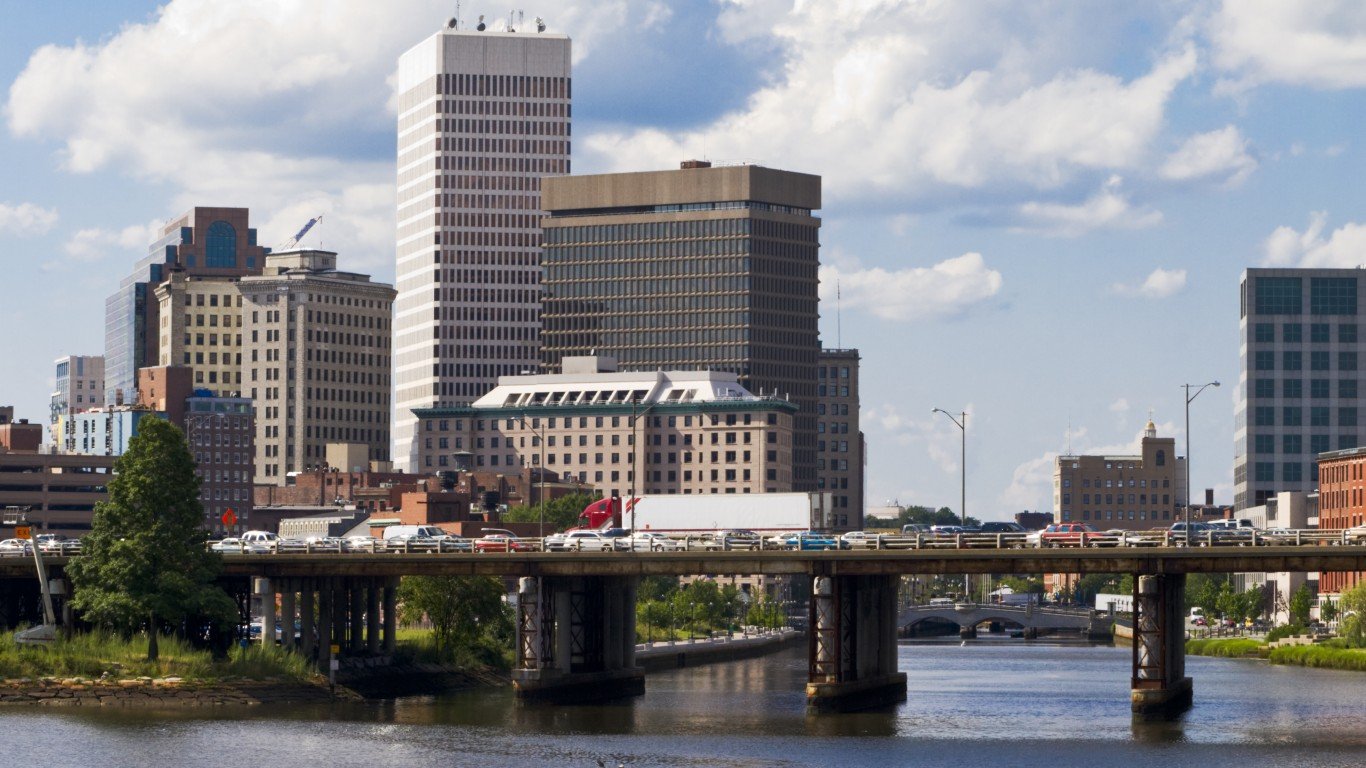
Rhode Island: Providence-Warwick*
> Avg. time lost to traffic delays, 2020: 33 hours per commuter
> Incidents of auto theft, 2021: 135 per 100,000 people (156 per 100,000 in state)
> Fatal crash rate, 2020: 6.6 per 100,000 people (6.0 per 100,000 in state)
> Avg. commute time to work in 2021: 25.6 minutes (24.8 minutes in state)
> Metro areas considered in state: 1
*Because Providence-Warwick is the only eligible metro area in Rhode Island, it ranks as the worst city to drive in by default.
[in-text-ad-2]
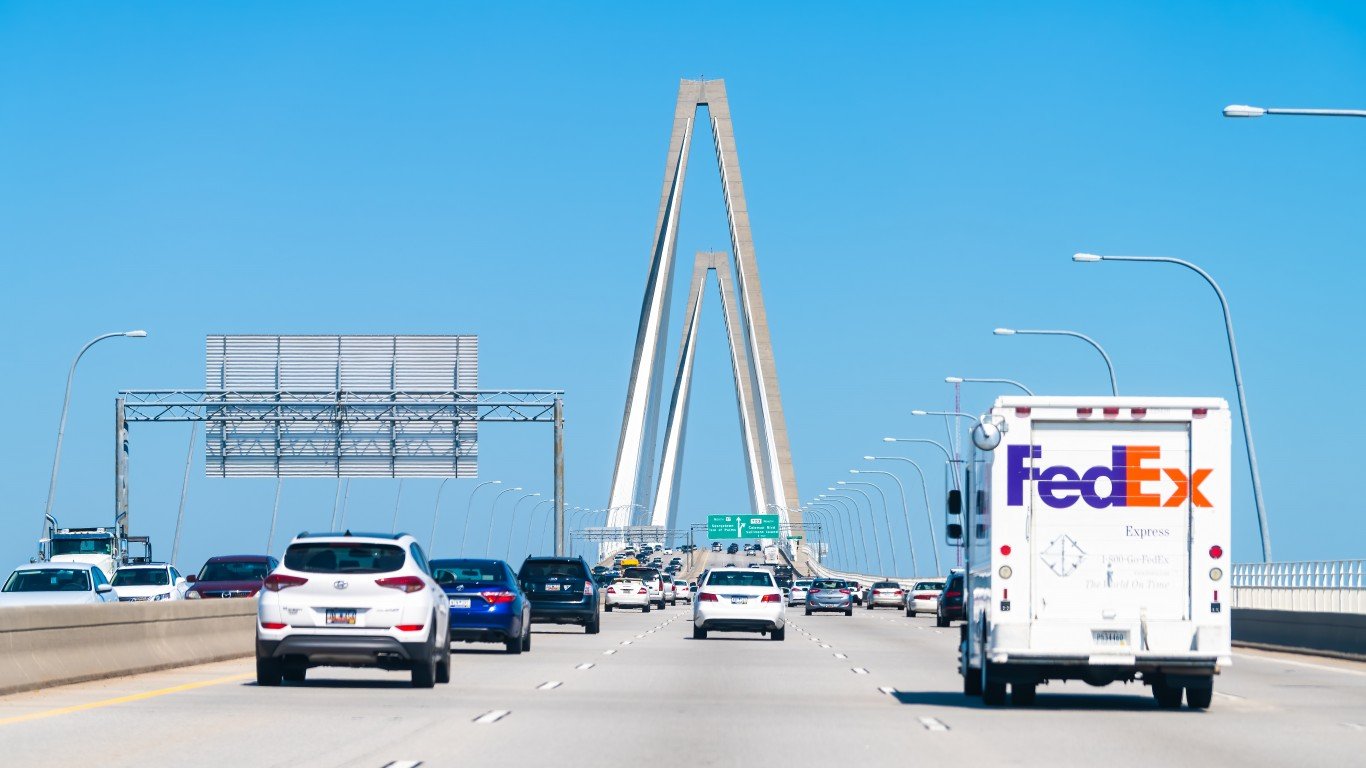
South Carolina: Charleston-North Charleston
> Avg. time lost to traffic delays, 2020: 26 hours per commuter
> Incidents of auto theft, 2021: 320 per 100,000 people (312 per 100,000 in state)
> Fatal crash rate, 2020: 17.0 per 100,000 people (18.5 per 100,000 in state)
> Avg. commute time to work in 2021: 26.5 minutes (25.6 minutes in state)
> Metro areas considered in state: 8
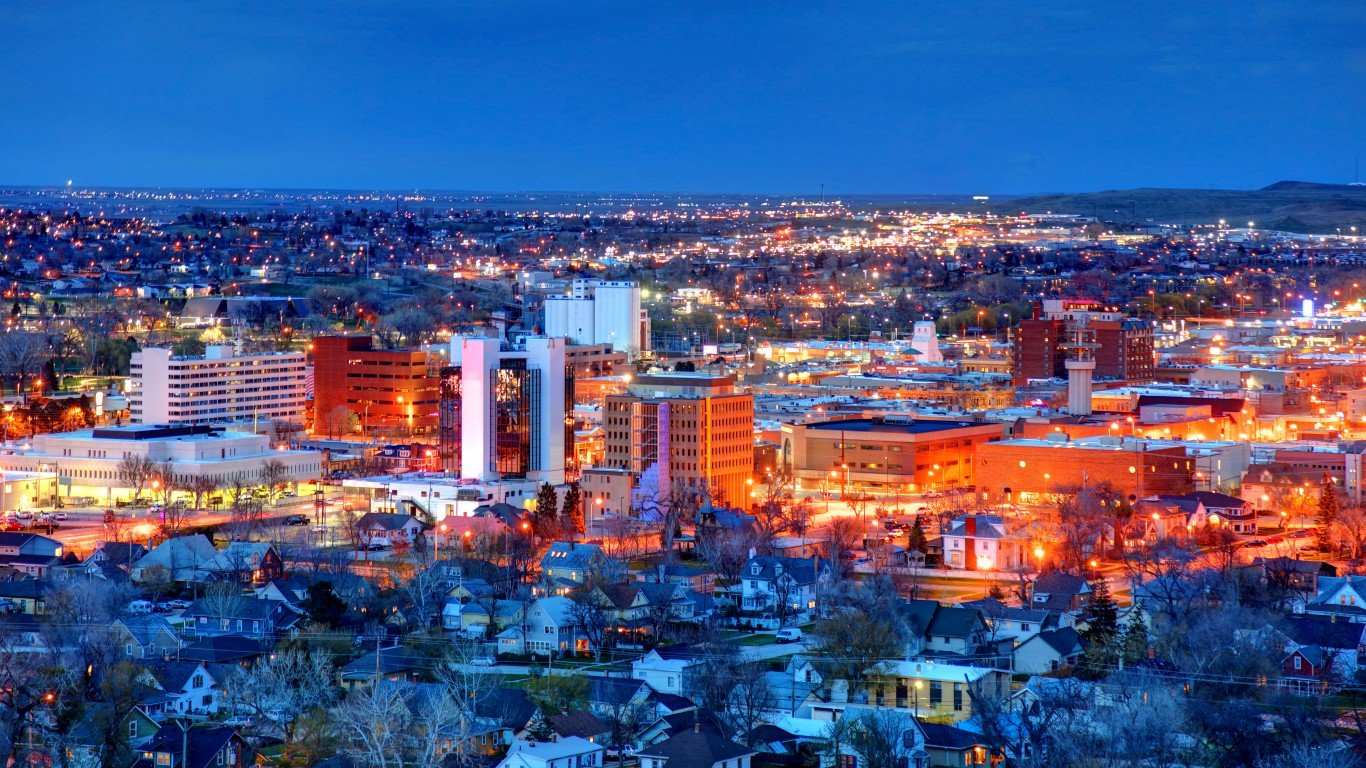
South Dakota: Rapid City
> Avg. time lost to traffic delays, 2020: 12 hours per commuter
> Incidents of auto theft, 2021: 405 per 100,000 people (264 per 100,000 in state)
> Fatal crash rate, 2020: 13.5 per 100,000 people (14.7 per 100,000 in state)
> Avg. commute time to work in 2021: 17.7 minutes (17.4 minutes in state)
> Metro areas considered in state: 2
[in-text-ad]
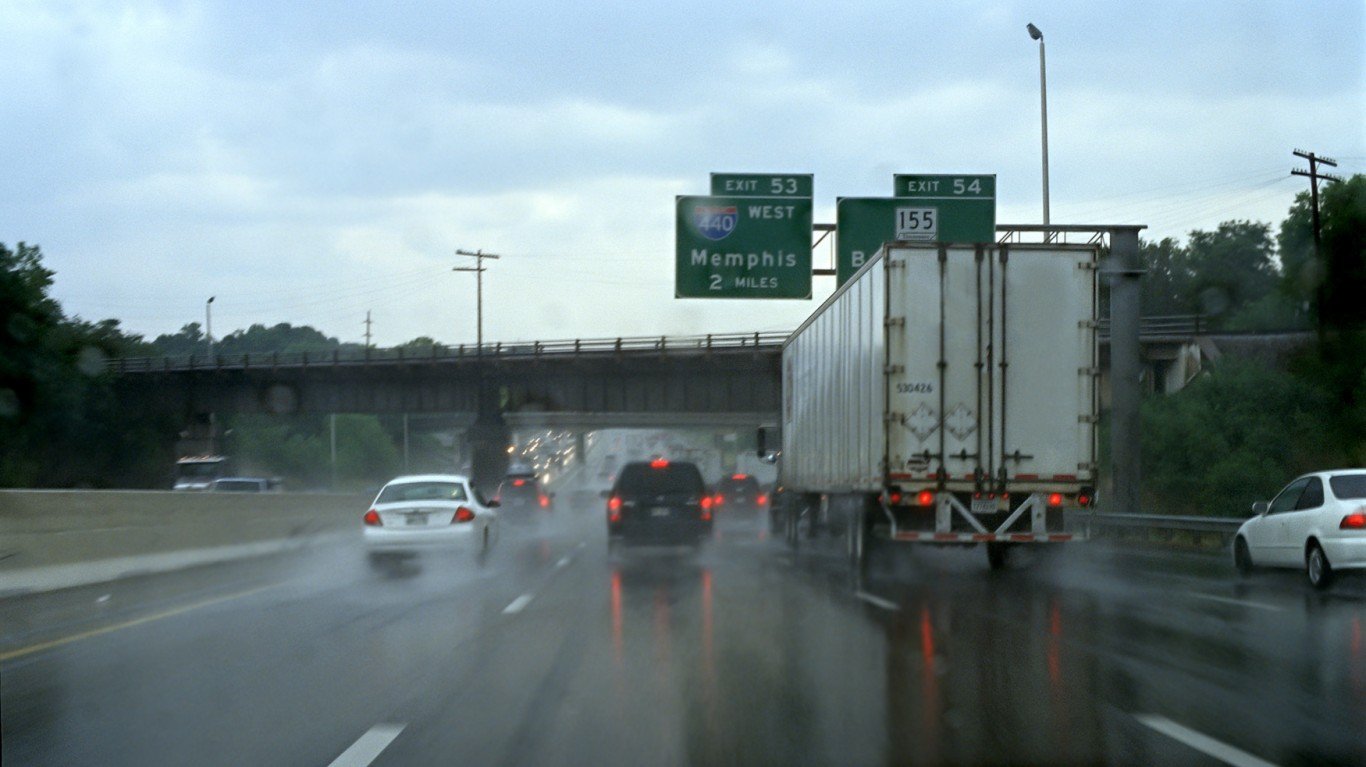
Tennessee: Memphis
> Avg. time lost to traffic delays, 2020: 28 hours per commuter
> Incidents of auto theft, 2021: 512 per 100,000 people (297 per 100,000 in state)
> Fatal crash rate, 2020: 22.9 per 100,000 people (16.0 per 100,000 in state)
> Avg. commute time to work in 2021: 23.8 minutes (25.2 minutes in state)
> Metro areas considered in state: 10
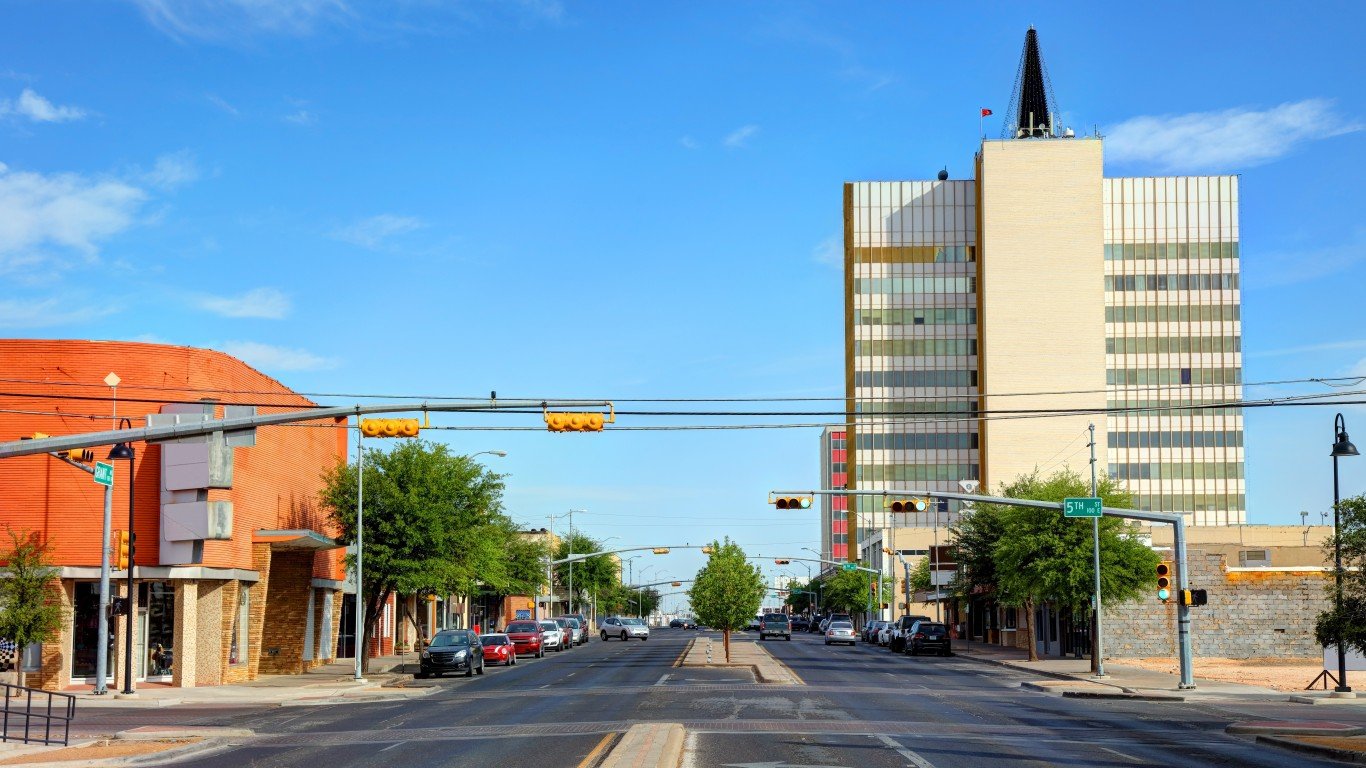
Texas: Odessa
> Avg. time lost to traffic delays, 2020: 30 hours per commuter
> Incidents of auto theft, 2021: 483 per 100,000 people (320 per 100,000 in state)
> Fatal crash rate, 2020: 31.7 per 100,000 people (11.9 per 100,000 in state)
> Avg. commute time to work in 2021: 24.9 minutes (25.9 minutes in state)
> Metro areas considered in state: 25
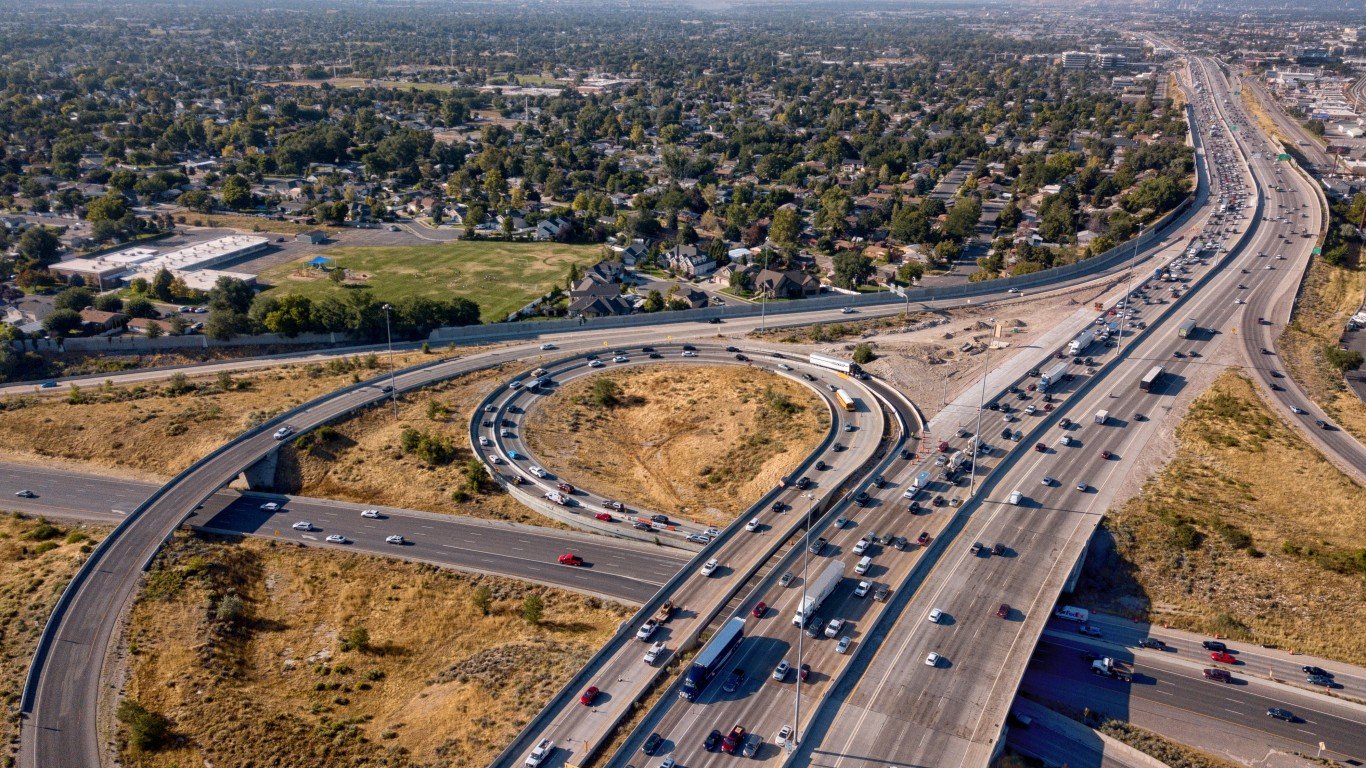
Utah: Salt Lake City
> Avg. time lost to traffic delays, 2020: 26 hours per commuter
> Incidents of auto theft, 2021: 469 per 100,000 people (256 per 100,000 in state)
> Fatal crash rate, 2020: 6.2 per 100,000 people (7.7 per 100,000 in state)
> Avg. commute time to work in 2021: 21.7 minutes (21.4 minutes in state)
> Metro areas considered in state: 5
[in-text-ad-2]

Vermont: Burlington-South Burlington*
> Avg. time lost to traffic delays, 2020: 19 hours per commuter
> Incidents of auto theft, 2021: 131 per 100,000 people (96 per 100,000 in state)
> Fatal crash rate, 2020: 6.6 per 100,000 people (9.0 per 100,000 in state)
> Avg. commute time to work in 2021: 23.1 minutes (23.0 minutes in state)
> Metro areas considered in state: 1
*Because Burlington-South Burlington is the only eligible metro area in Vermont, it ranks as the worst city to drive in by default.
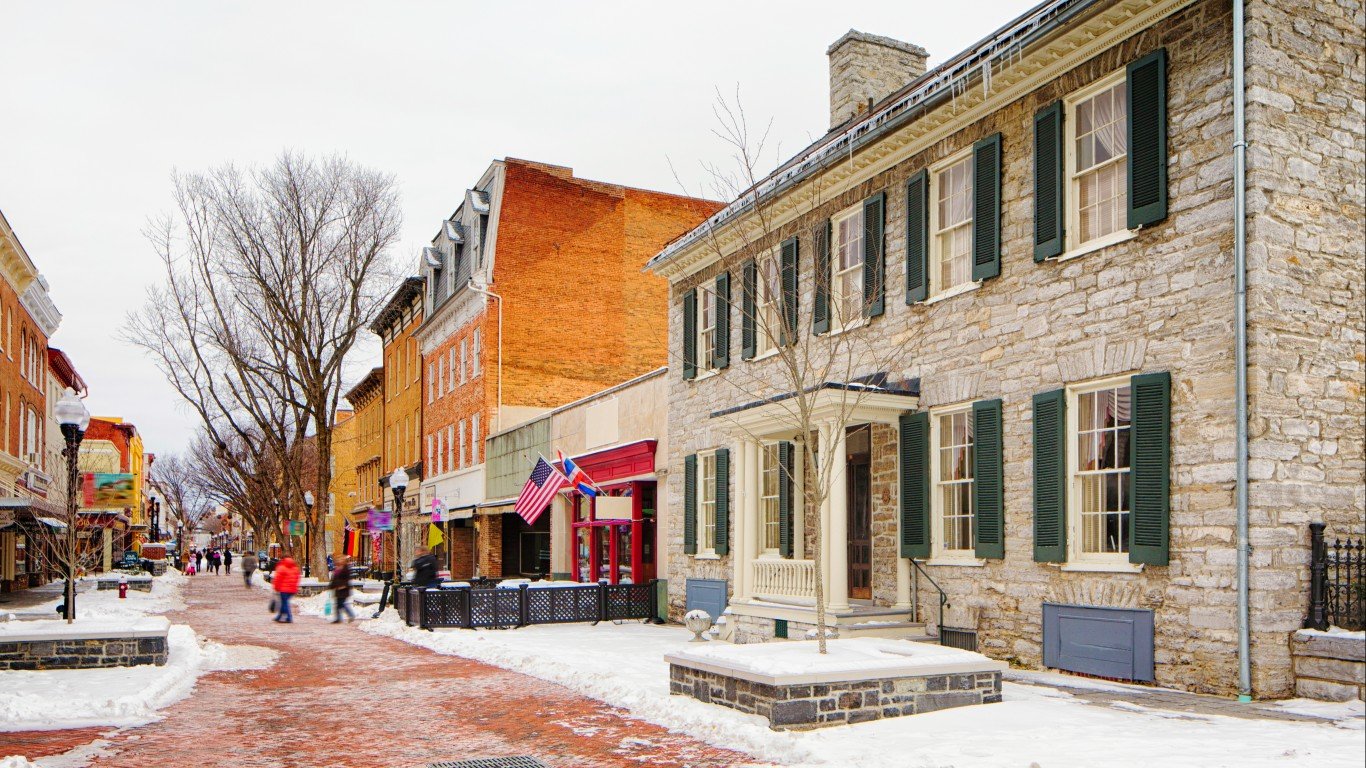
Virginia: Winchester
> Avg. time lost to traffic delays, 2020: 22 hours per commuter
> Incidents of auto theft, 2021: 75 per 100,000 people (143 per 100,000 in state)
> Fatal crash rate, 2020: 16.8 per 100,000 people (9.2 per 100,000 in state)
> Avg. commute time to work in 2021: 28.9 minutes (26.4 minutes in state)
> Metro areas considered in state: 9
[in-text-ad]
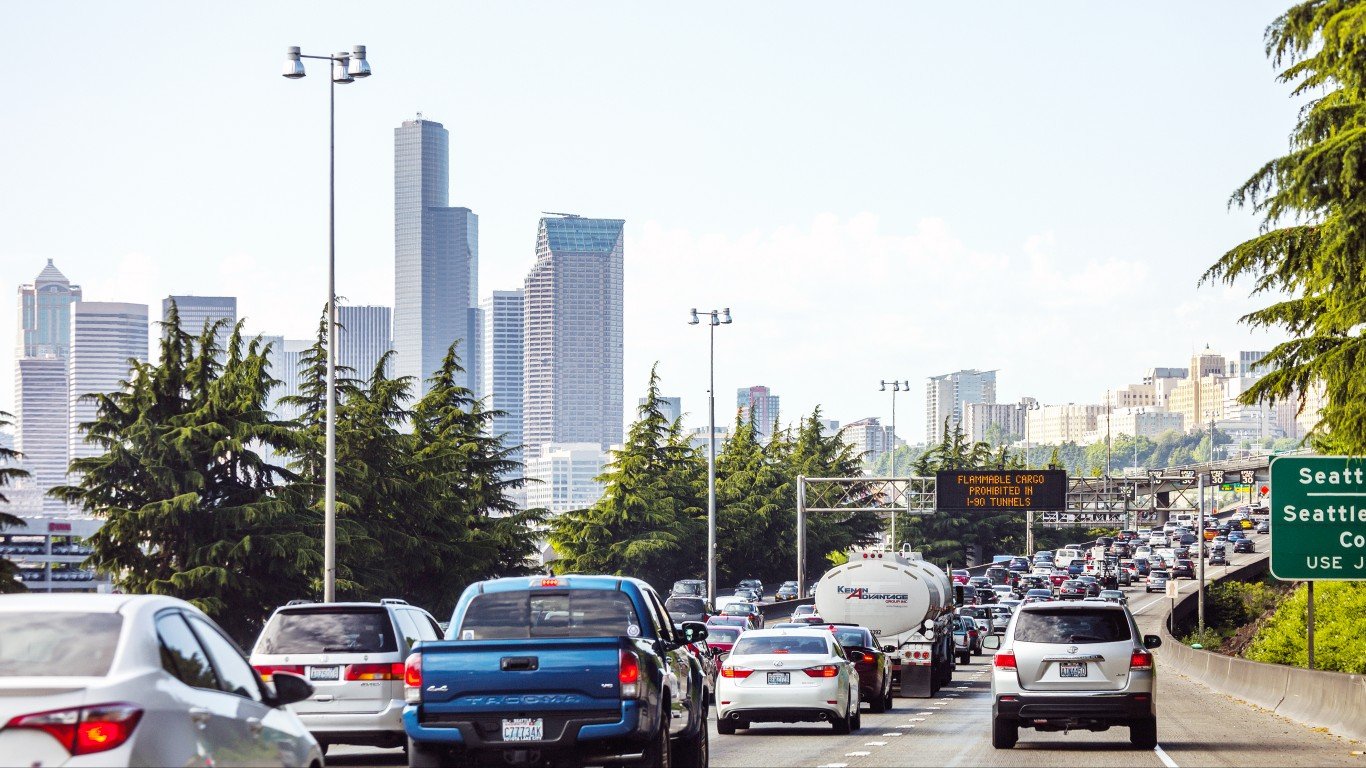
Washington: Seattle-Tacoma-Bellevue
> Avg. time lost to traffic delays, 2020: 31 hours per commuter
> Incidents of auto theft, 2021: 582 per 100,000 people (462 per 100,000 in state)
> Fatal crash rate, 2020: 5.3 per 100,000 people (6.8 per 100,000 in state)
> Avg. commute time to work in 2021: 28.5 minutes (26.0 minutes in state)
> Metro areas considered in state: 11

West Virginia: Charleston
> Avg. time lost to traffic delays, 2020: 12 hours per commuter
> Incidents of auto theft, 2021: 234 per 100,000 people (129 per 100,000 in state)
> Fatal crash rate, 2020: 11.5 per 100,000 people (14.0 per 100,000 in state)
> Avg. commute time to work in 2021: 24.8 minutes (25.7 minutes in state)
> Metro areas considered in state: 7
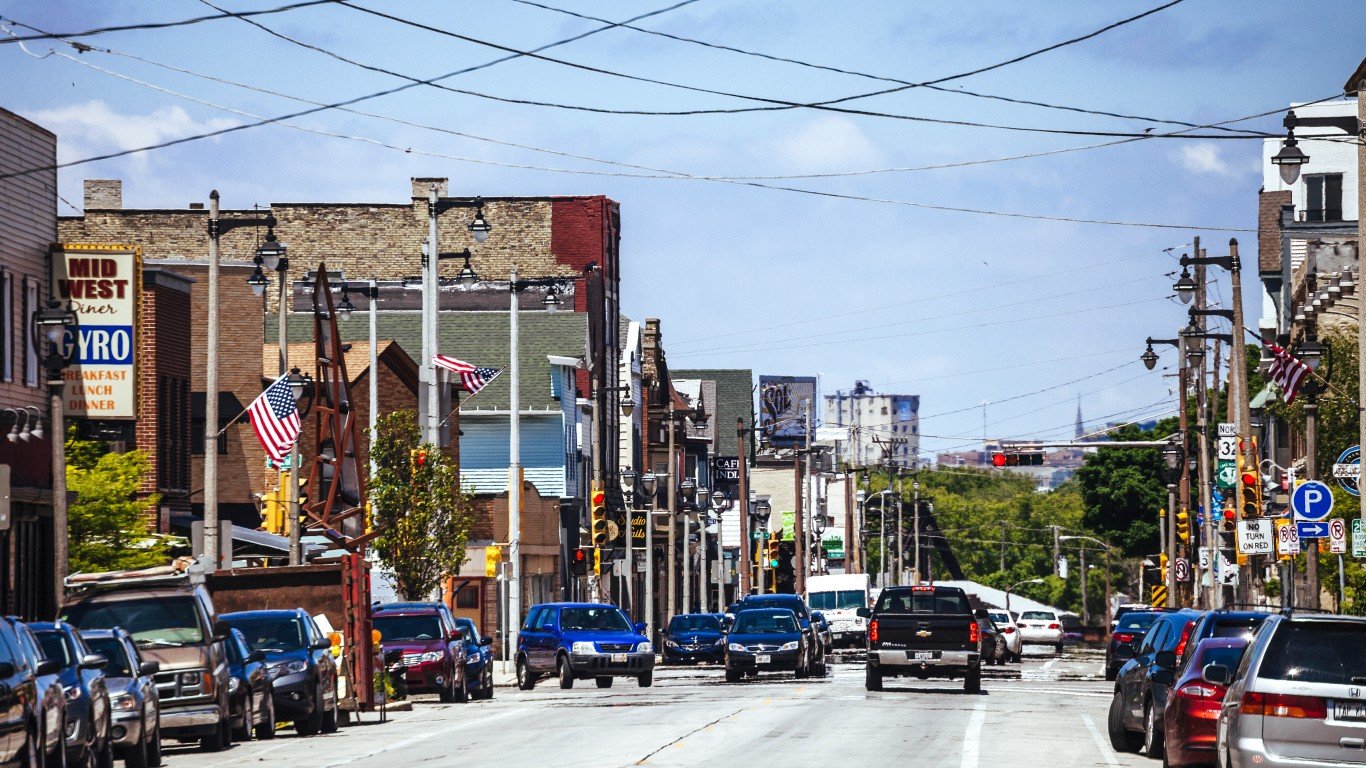
Wisconsin: Milwaukee-Waukesha
> Avg. time lost to traffic delays, 2020: 29 hours per commuter
> Incidents of auto theft, 2021: 598 per 100,000 people (237 per 100,000 in state)
> Fatal crash rate, 2020: 7.3 per 100,000 people (9.5 per 100,000 in state)
> Avg. commute time to work in 2021: 22.0 minutes (21.9 minutes in state)
> Metro areas considered in state: 12
[in-text-ad-2]
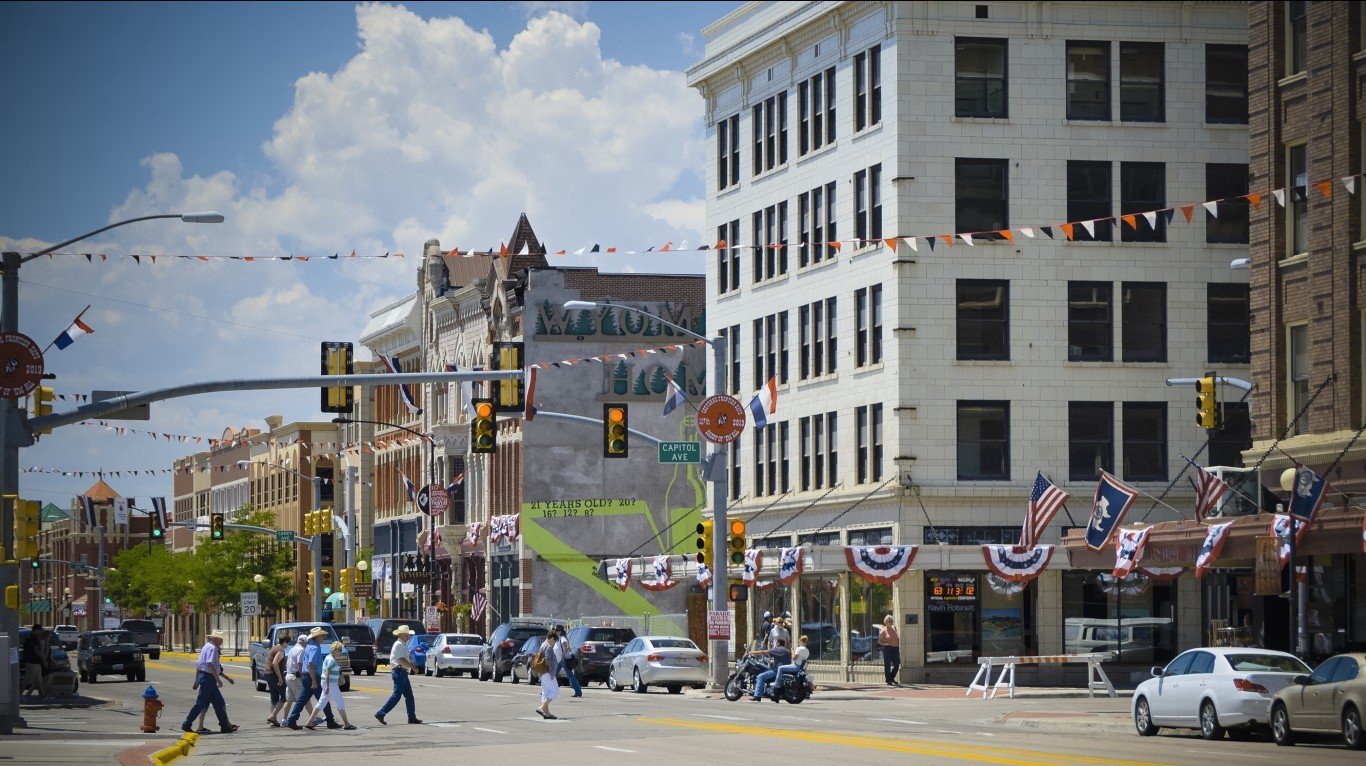
Wyoming: Cheyenne
> Avg. time lost to traffic delays, 2020: 6 hours per commuter
> Incidents of auto theft, 2021: 407 per 100,000 people (162 per 100,000 in state)
> Fatal crash rate, 2020: 11.9 per 100,000 people (19.7 per 100,000 in state)
> Avg. commute time to work in 2021: 19.1 minutes (18.3 minutes in state)
> Metro areas considered in state: 2
Methodology
To determine the worst cities to drive in each state, 24/7 Wall St. created an index assessing the safety, traffic congestion, and convenience of driving in 378 metropolitan statistical areas.
Within each state, metro areas were ranked on four measures: deadly car accidents per 100,000 people in 2020, reported car thefts per 100,000 people in 2021, average hours lost to traffic congestion per commuter in 2020, and average commute time in 2021 among those not working from home.
It is important to note that four states – Delaware, New Hampshire, Rhode Island, and Vermont – have only one metropolitan area. As a result, the metro area listed in these states ranks as the worst by default only.
Data on the number of fatal car crashes in 2020 is from the National Highway Traffic Safety Administration’s Fatality and Injury Reporting System Tool. We adjusted the total number of fatal accidents per 100,000 people at both the state and metro area level using population data from the U.S. Census Bureau’s 2021 American Community Survey.
The number of reported car thefts per 100,000 people in 2021 is from the National Insurance Crime Bureau’s 2021 Hot Spots Vehicle Theft Report.
The number of hours lost to traffic congestion in 2020 per commuter is from the Texas A&M Transportation Institute’s 2021 Urban Mobility Report. The urban areas covered in the report may not be coterminous with the U.S. Census Bureau’s metropolitan area definitions, but there is always sufficient overlap.
Finally, data on average commute time for area residents 16 or over who do not work at home is from the U.S. Census Bureau’s 2021 ACS.
Smart Investors Are Quietly Loading Up on These “Dividend Legends”
If you want your portfolio to pay you cash like clockwork, it’s time to stop blindly following conventional wisdom like relying on Dividend Aristocrats. There’s a better option, and we want to show you. We’re offering a brand-new report on 2 stocks we believe offer the rare combination of a high dividend yield and significant stock appreciation upside. If you’re tired of feeling one step behind in this market, this free report is a must-read for you.
Click here to download your FREE copy of “2 Dividend Legends to Hold Forever” and start improving your portfolio today.
Thank you for reading! Have some feedback for us?
Contact the 24/7 Wall St. editorial team.
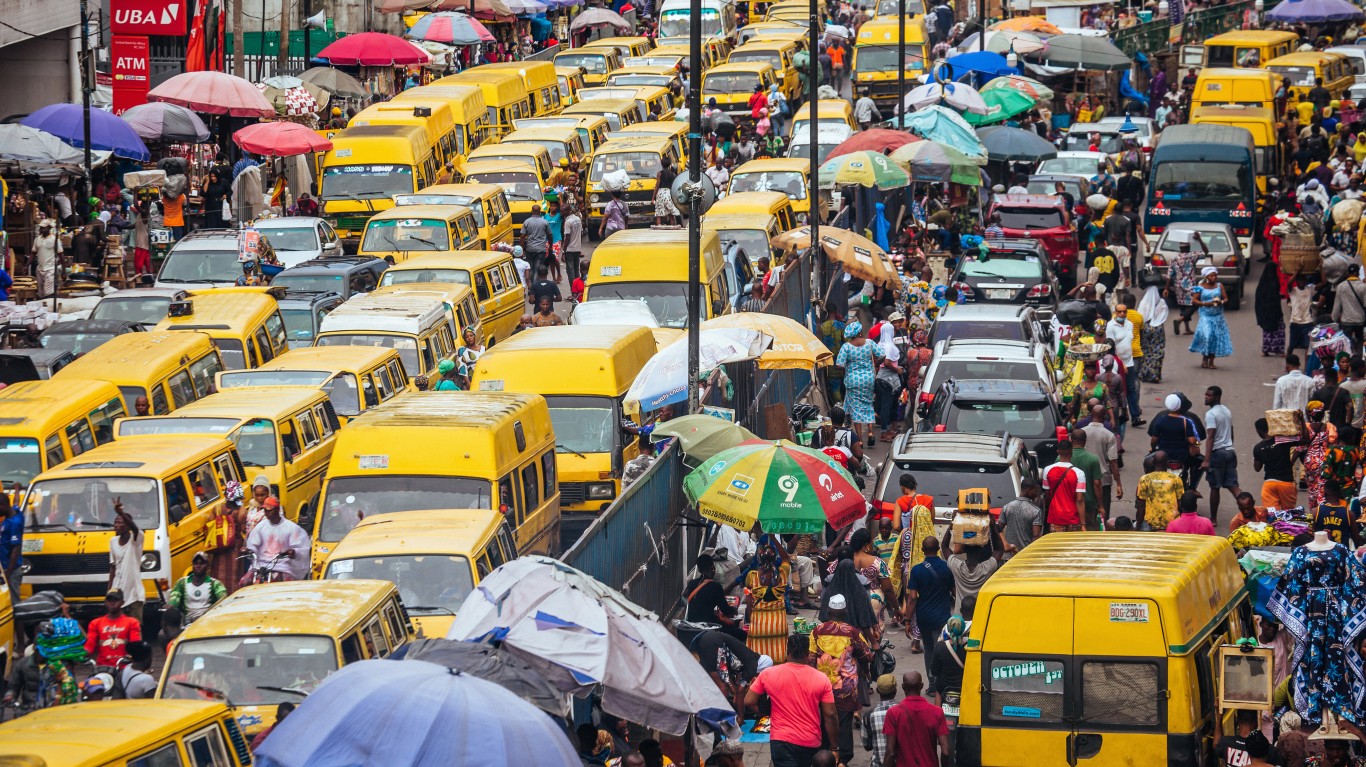 24/7 Wall St.
24/7 Wall St.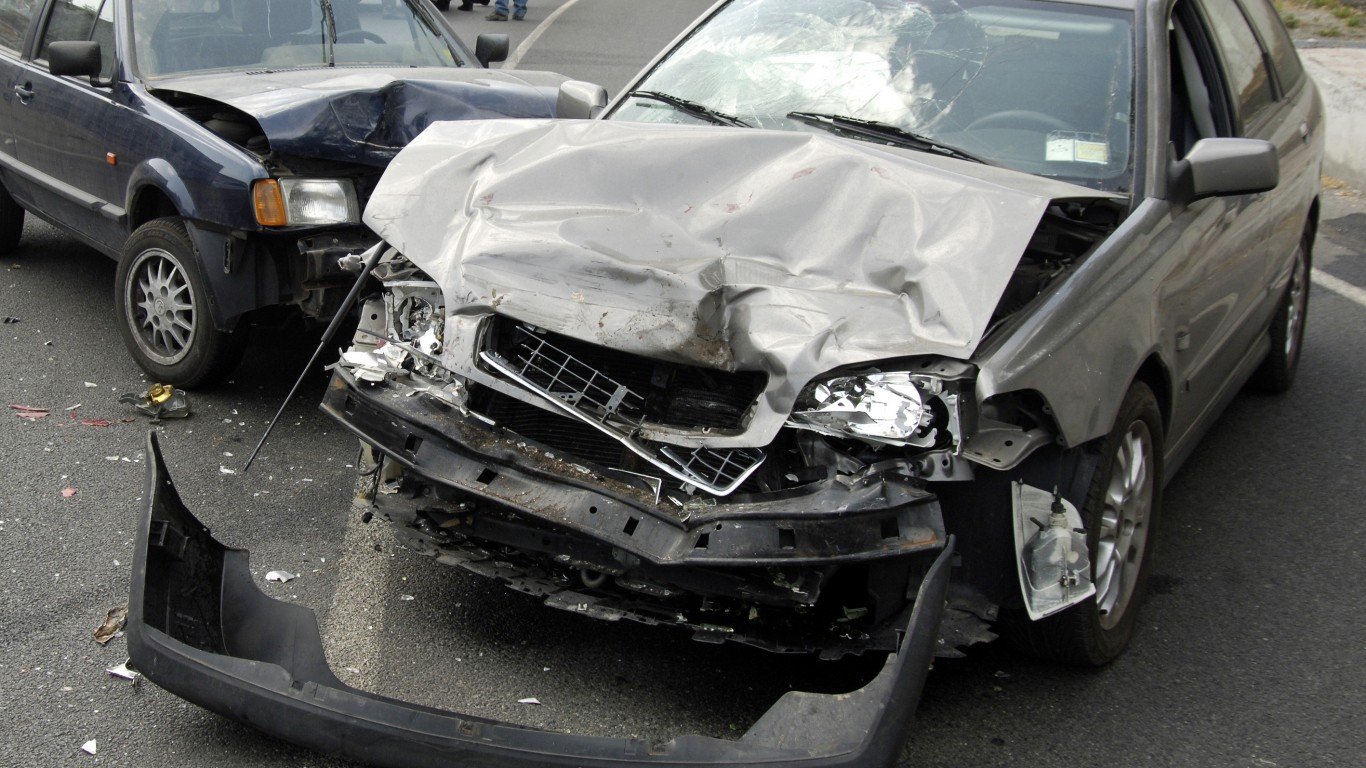 24/7 Wall St.
24/7 Wall St.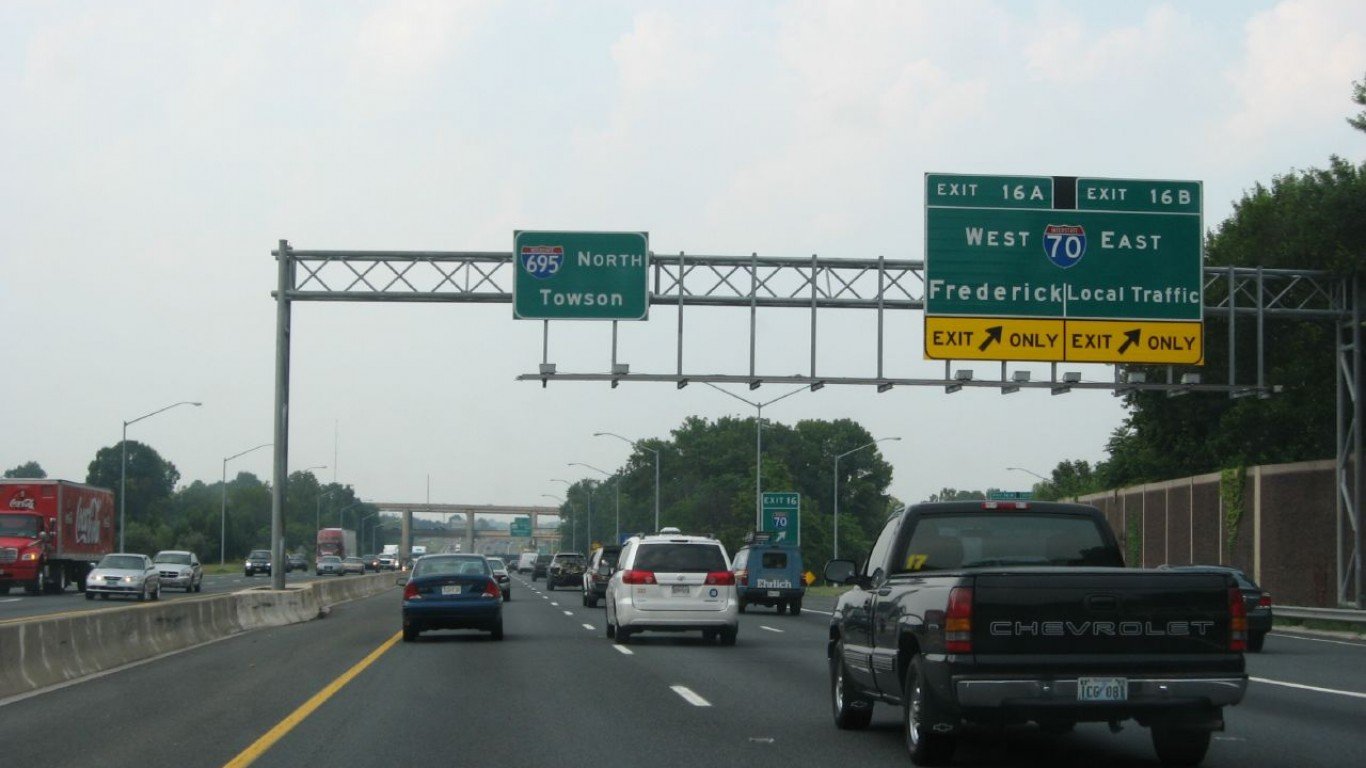
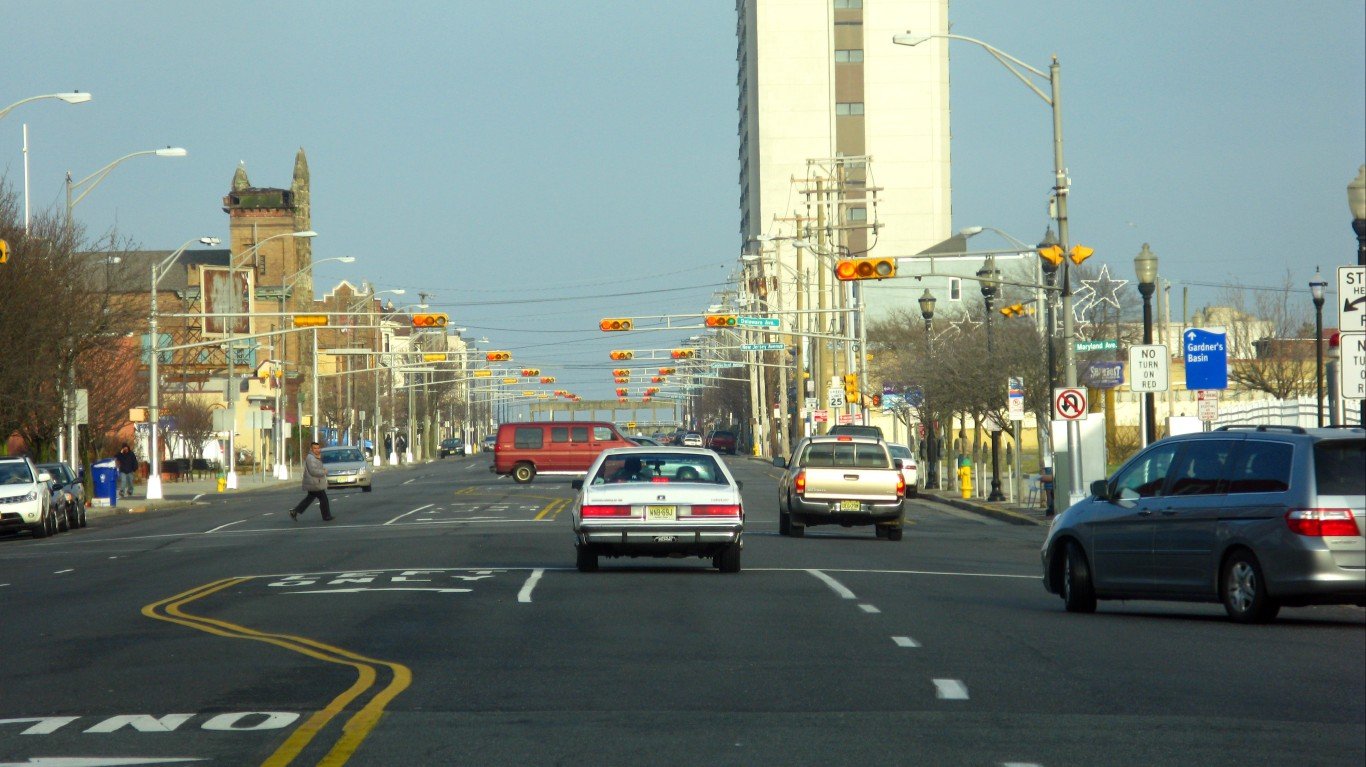
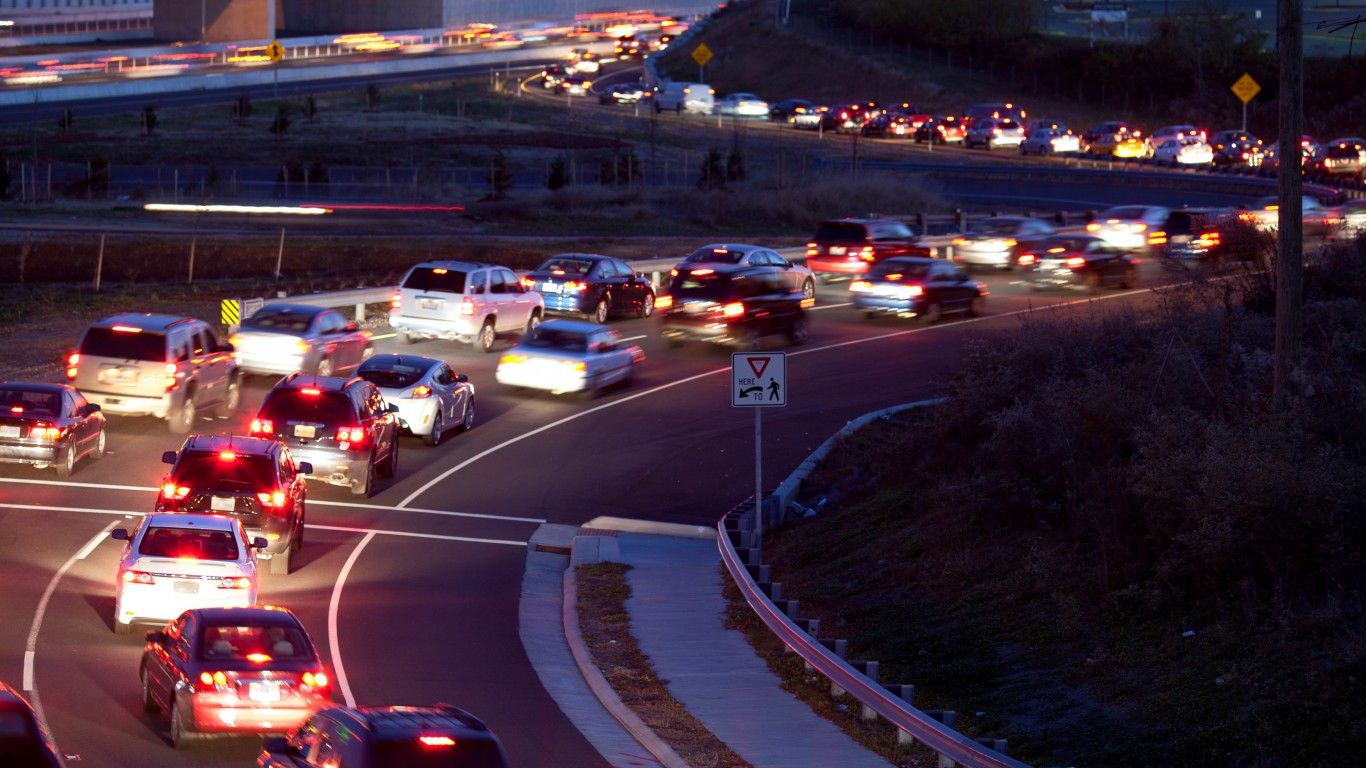 24/7 Wall St.
24/7 Wall St.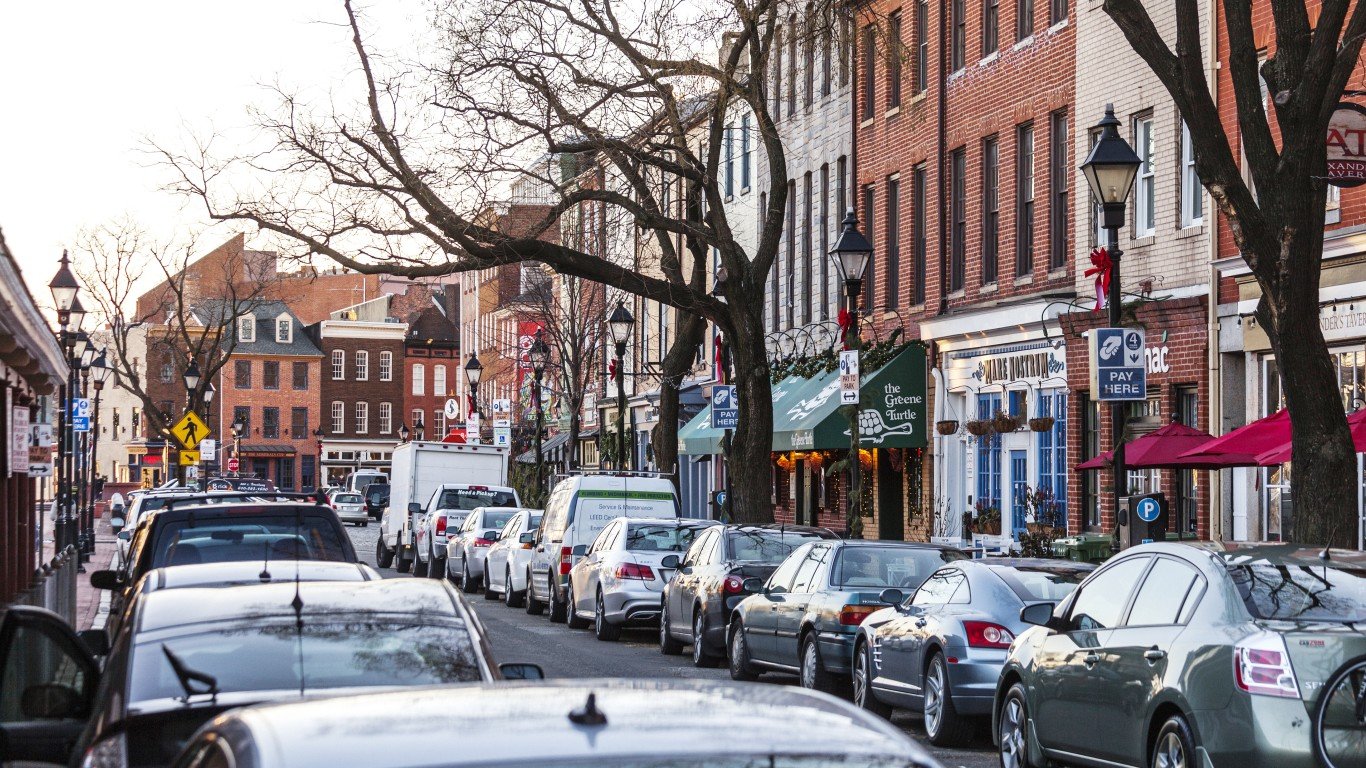 24/7 Wall St.
24/7 Wall St.
